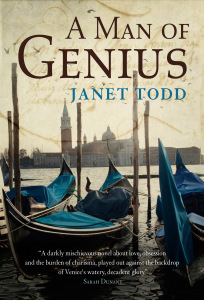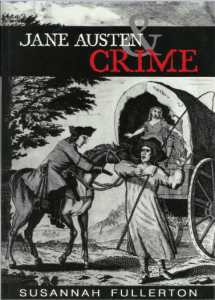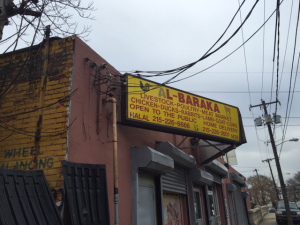Sarah Emsley's Blog, page 26
January 27, 2016
“English verdure”
 Janet Todd has recently retired after half a century of full-time teaching and administering mainly in Britain and America, and she has, she says, “turned with relief to reading and writing novels.” Lady Susan Plays the Game, an Austen spin-off, was published in 2013. Her first original fiction, A Man of Genius, set in Venice and Regency London, will be published in March by Bitter Lemon Press. I looked up some of the advance praise for the novel and found that Philippa Gregory calls A Man of Genius “Strange and haunting, a gothic novel with a modern consciousness.” Sounds irresistible, doesn’t it?
Janet Todd has recently retired after half a century of full-time teaching and administering mainly in Britain and America, and she has, she says, “turned with relief to reading and writing novels.” Lady Susan Plays the Game, an Austen spin-off, was published in 2013. Her first original fiction, A Man of Genius, set in Venice and Regency London, will be published in March by Bitter Lemon Press. I looked up some of the advance praise for the novel and found that Philippa Gregory calls A Man of Genius “Strange and haunting, a gothic novel with a modern consciousness.” Sounds irresistible, doesn’t it?
Janet is the author and editor of many books on Austen and other writers, including Jane Austen: Her Life, Her Times, Her Novels; The Cambridge Companion to Pride and Prejudice; and biographies of Mary Wollstonecraft and Aphra Behn. She is General Editor of the Cambridge Edition of the Works of Jane Austen. It’s my pleasure to introduce her guest post for Emma in the Snow, on “English verdure.”
A recent conference at Chawton House to honour Marilyn Butler reminded us all of her influential Jane Austen and the War of Ideas. Written 40 years ago, it placed Austen within her literary-political context, arguing for an ideologically conservative and patriotic author committed to the Anglican Tory values of her family. Since then it has provoked critics seeking to fit Austen into present orthodoxies, relieving her of possible taints of classism, sexism and racism. Also nationalism: the Englishness of Emma as she stands in the grounds of George Knightley’s ancient Donwell Abbey.
It’s near midsummer. Emma regards the unimproved estate:
she viewed the respectable size and style of the building, its suitable, becoming characteristic situation, low and sheltered—its ample gardens stretching down to meadows washed by a stream, of which the Abbey, with all the old neglect of prospect, had scarcely a sight—and its abundance of timber in rows and avenues, which neither fashion nor extravagance had rooted up. … The house … was just what it ought to be, and it looked what it was.
She strays further.
It was hot; and … they insensibly followed one another to the delicious shade of a broad short avenue of limes, which stretching beyond the garden at an equal distance from the river, seemed the finish of the pleasure grounds.—It led to nothing; nothing but a view at the end over a low stone wall with high pillars, which seemed intended, in their erection, to give the appearance of an approach to the house, which never had been there.
She sees woods, slopes and
Abbey-Mill Farm, with meadows in front, and the river making a close and handsome curve around it.
It was a sweet view—sweet to the eye and the mind. English verdure, English culture, English comfort, seen under a sun bright, without being oppressive. (Volume 3, Chapter 6)
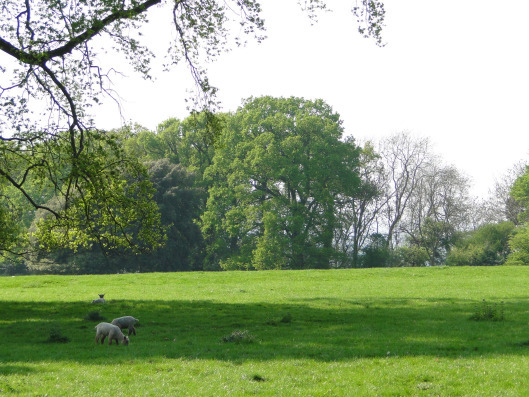
Hidcote Bartrim (Janet’s photo)
All moderation, ease, and balance—without the violent sun of southern countries. The grounds Emma contemplates are not formal, contrived and abstract, not planned in the way of French and British reformers of land, people or states, its avenues of old established lime trees, its views of a satisfying “nothing.”
It’s well that she likes it. In contrast not only to the cosmopolitan naval men of Persuasion and Mansfield Park, but also to Fanny Price and Anne Elliot, who experience different scenes and cultures, the wealthier, more privileged Emma is almost stationary, contained in her small community of Highbury. Though the most imaginative and dominant, she is the most controlled of the heroines. She’s almost imprisoned at home, where she pays for her significance by thraldom to a selfish, demanding and adoring father whom she pretty well infantilizes. The sense of claustrophobia is real—at the end as well as at the beginning. She has realised her love for Mr. Knightley in part through snobbish distaste at the horror of a Jane or Harriet as mistress of Donwell Abbey. When her father dies, she herself will be fixed there for life.
Nationalism was a conflicted notion in Austen’s time. Liberal thinkers of the 1790s yearned for an internationalism of spirit, comically vanquished here as George of England defeats Frank for an Emma—whom the latter never actually wanted. In the early 19th century national stories were all the rage, bardic tales of the “Celtic fringe”: Sydney Owenson’s Wild Irish Girl, many Irish and Welsh works of Maria Edgeworth, Iolo Morganwg, and Walter Scott. There was no equivalent for England.
Or was there in Austen’s Emma?
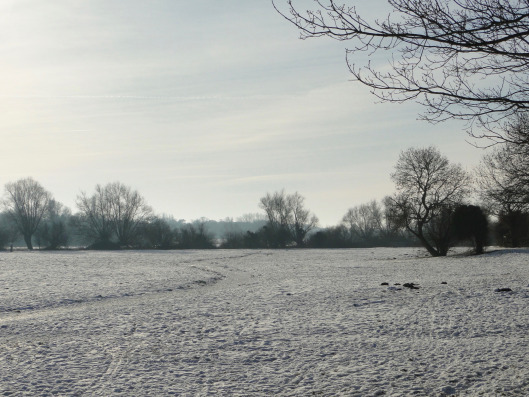
Cambridge in the snow (Janet’s photo)
In the other two novels begun in Chawton, Persuasion and Mansfield Park, the navy stands for the nation, defined through men employed to guard it. This nationalism is tied to growth in state administration: Anne Frey therefore sees a new bureaucratic identify for Britishness. This identity develops against the Englishness of the landed gentry, an aristocratic sense of place, ownership and evolving organic community. (See Anne Frey, “A Nation without Nationalism: the Reorganization of Feeling in Jane Austen’s Persuasion,” in Novel [March 2005].) If this is so, unlike the other two novels, Emma is about Englishness.
In which case, in its insistence on the value of small things and emphasis on “nothing” it may gently mock the fashionable fictions that made their nationalisms exotic, full and a little simplified. But it may also—just a little—ironise Emma and her provincial vision.
The Scottish philosopher David Hume had commented on parochial attitudes of English gentlemen: devoted to “domestic affairs” and everyday objects. Irish and Scottish nationalist writers of Austen’s time would have made poverty clearly part of a story and openly addressed the politics underpinning their vision. Just before her musing on England, Emma had complacently considered the established gentry family that owns the estate. But here, looking across Donwell grounds, she makes no class assumptions, not even registering the tenancy of Robert Martin whom she’d so despised as Harriet’s suitor. Her looking, though containing agriculture, is primarily aesthetic.
And she sees a pastoral England—just before she marries a magistrate and working farmer who will be helped by the capital she brings. Jane Fairfax, who knows a world beyond Highbury, leaves with the man who yearns for continental travel. Emma may well see the sea but fleetingly: she will live yoked physically to her father and socially to two women who irritate her: Miss Bates and Mrs. Elton. She will have to stay longer in the homes of the poor and put up with the irritation of adjacent lives in her patch of gentle “English verdure.”
Quotations are from the Cambridge edition of Emma, edited by Richard Cronin and Dorothy McMillan (2005).
Eleventh in a series of blog posts celebrating 200 years of Jane Austen’s Emma. To read more about all the posts in the series, visit Emma in the Snow. Coming soon: guest posts by Elisabeth Lenckos, Carol Chernega, and Cheryl Kinney.
Subscribe by email or follow the blog so you don’t miss these fabulous contributions to the celebrations! And/or follow along by connecting with me on Facebook , Pinterest , or Twitter ( @Sarah_Emsley ).


January 22, 2016
The Gypsies in Emma
 Susannah Fullerton is President of the Jane Austen Society of Australia and the author of Jane Austen and Crime (2004), A Dance with Jane Austen: How a Novelist and her Characters went to the Ball (2012), and Happily Ever After: Celebrating Jane Austen’s Pride and Prejudice (2013). She writes about her wide-ranging literary interests for her Google Classic Novels site and in her newsletter, “Notes from a Book Addict,” and she leads literary tours to Jane Austen country, and to France, USA, Ireland, and Italy for Australians Studying Abroad. Sometimes, she takes her tour groups to one of my own favourite places, Prince Edward Island, to visit Green Gables and other literary sites. Susannah is Patron of the Kipling Society of Australia, and she’s the author and presenter of the audio CD Finding Katherine Mansfield (2009). I’m pleased to introduce her guest post for Emma in the Snow.
Susannah Fullerton is President of the Jane Austen Society of Australia and the author of Jane Austen and Crime (2004), A Dance with Jane Austen: How a Novelist and her Characters went to the Ball (2012), and Happily Ever After: Celebrating Jane Austen’s Pride and Prejudice (2013). She writes about her wide-ranging literary interests for her Google Classic Novels site and in her newsletter, “Notes from a Book Addict,” and she leads literary tours to Jane Austen country, and to France, USA, Ireland, and Italy for Australians Studying Abroad. Sometimes, she takes her tour groups to one of my own favourite places, Prince Edward Island, to visit Green Gables and other literary sites. Susannah is Patron of the Kipling Society of Australia, and she’s the author and presenter of the audio CD Finding Katherine Mansfield (2009). I’m pleased to introduce her guest post for Emma in the Snow.
The encounter with the gypsies—such a small incident in the novel, and yet it achieves so much. The day after the Crown Inn Ball Harriet Smith and her school friend Miss Bickerton go out for a walk and encounter a group of gypsies: “half a dozen children, headed by a stout woman and a great boy, all clamorous and impertinent” (Volume 3, Chapter 3). The gypsies want money from the two girls and seem prepared to use violence to get it. Miss Bickerton runs away as fast as her legs will carry her, but Harriet suffers cramp as a result of all her energetic dancing the night before, and is left to the mercies of these gypsies. She gives them a shilling, but they demand more and poor Harriet is terrified. She begs the group not “to use her ill.” Of course, as every reader of Emma knows, she is then rescued by Frank Churchill, who gets her safely to Hartfield where she faints dead away.
A modern reader might condemn Harriet for her timidity and her fainting, but Jane Austen’s contemporary readers would all have known just why Harriet faints. Gypsies were seen as a major problem in England in Austen’s time. There had been an attempt in 1563 to expel every gypsy from the country, but that failed and for the next centuries gypsies eked out an existence on the margins of society—pilfering and moving on, raiding hen-houses and moving on, avoiding the authorities as much as possible. In Jane Austen’s juvenile work Evelyn, the not very heroic hero Mr. Gower is terrified as he rides home at night and closes his eyes “to prevent his seeing either Gypsies or Ghosts.” Such was society’s hatred of gypsies that it actually became a hanging offence to be found “conversing with gypsies.” The legal authorities of England took it for granted that if you were in conversation with a gypsy, then it must be for no good purpose. In 1782 a fourteen-year-old girl, desperately protesting her innocence, was hanged for being found in the company of gypsies. Of course any humane judge would be most unlikely to put poor Harriet to death for her misadventure, but technically Harriet Smith commits a serious crime that could result in her life being terminated. No wonder she faints! Contemporary readers would have been far more sympathetic to her peril and would have totally understood her reaction.
“The Gypsies did not wait for the operations of justice: they took themselves off in a hurry.” Emma promises Frank that she will give “notice of there being such a set of people in the neighbourhood to Mr Knightley.” He is, of course, the local magistrate, and knows how to deal with such a gang. Emma’s nephews then regularly demand the exciting tale of Harriet and the gypsies, “tenaciously setting her right if she varied in the slightest particular from the original recital” and that seems to be the end of the business. But of course it is these very gypsies and their attack which start Emma linking Harriet and her rescuer romantically in her own mind—and we all know into what trouble that leads her.
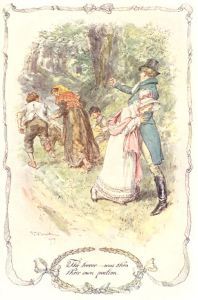
“The terror … was then their own portion.” Illustration by C.E. Brock (Source: Mollands.net).
But do those gypsies make a second appearance in the novel? In the final chapter “Mrs Weston’s poultry-house was robbed one night of all her turkies—evidently by the ingenuity of man. Other poultry-yards in the neighbourhood also suffered.—Pilfering was housebreaking to Mr Woodhouse’s fears.—He was very uneasy; and but for the sense of his son-in-law’s protection, would have been under wretched alarm every night of his life” (Volume 3, Chapter 19). It is for this reason that he agrees, far more willingly than anyone expected, to Emma’s marriage, so that Mr Knightley can live at Hartfield and protect them all. We do not know for certain that the poultry is stolen by gypsies, but they must be the first suspects—they surely scouted out the neighbourhood when there previously, and a quick raid back to grab some chickens and turkeys is highly likely. If so, they are responsible for bringing about the marriage of the hero and heroine of the novel—no mean accomplishment by the novel’s most unsavoury characters.
The gypsies in Emma give us a glimpse of the crime that was so prevalent in Georgian society. This may not be an obvious feature of Jane Austen’s novels, but it is an important one, as I discovered when I wrote my book Jane Austen and Crime. Jane Austen does have her darker side—duels, thefts, elopement, hangings, adultery, gaols, and even murder all have a place in her writings, and learning more about the crimes she depicts adds much to contemporary understanding of her novels.
Tenth in a series of blog posts celebrating 200 years of Jane Austen’s Emma. To read more about all the posts in the series, visit Emma in the Snow. Coming soon: guest posts by Janet Todd, Carol Chernega, and Elisabeth Lenckos.
Subscribe by email or follow the blog so you don’t miss these fabulous contributions to the celebrations! And/or follow along by connecting with me on Facebook, Pinterest, or Twitter (@Sarah_Emsley).


January 20, 2016
Mrs. Elton’s Donkey
 Diana Birchall has imagined a conversation between Mrs. Elton and her husband for Emma in the Snow, and I’m delighted to share her story with you here. One of the things I like best about hosting this celebration for Emma is the range of different approaches to the novel. Contributors to this series and to the celebration I hosted for Mansfield Park in 2014 include novelists, journalists, bloggers, booksellers, librarians, lawyers, and doctors, along with graduate students, postdocs, professors, and independent scholars. I’m always interested to see each contributor’s perspective on Jane Austen’s novels, and I like that sometimes the guest posts include recipes, for example, or fiction, along with literary analysis.
Diana Birchall has imagined a conversation between Mrs. Elton and her husband for Emma in the Snow, and I’m delighted to share her story with you here. One of the things I like best about hosting this celebration for Emma is the range of different approaches to the novel. Contributors to this series and to the celebration I hosted for Mansfield Park in 2014 include novelists, journalists, bloggers, booksellers, librarians, lawyers, and doctors, along with graduate students, postdocs, professors, and independent scholars. I’m always interested to see each contributor’s perspective on Jane Austen’s novels, and I like that sometimes the guest posts include recipes, for example, or fiction, along with literary analysis.
 Diana recently retired from her career as a story analyst at Warner Bros., where she read novels to see if they would make movies. The author of a scholarly biography of her grandmother, the first Asian American novelist, Onoto Watanna (University of Illinois Press), and several “Austenesque” novels, including Mrs. Darcy’s Dilemma and Mrs. Elton in America (Sourcebooks), she has also written several plays performed at JASNA AGMs. In Defense of Mrs. Elton, written by Diana and illustrated by Juliet McMaster, can be read on the JASNA website. Diana’s guest post for my Mansfield Park series was a short story entitled “The Scene-Painter.” She tells me she plans to write more novels now that she no longer has to spend her days reading about dragons and robots.
Diana recently retired from her career as a story analyst at Warner Bros., where she read novels to see if they would make movies. The author of a scholarly biography of her grandmother, the first Asian American novelist, Onoto Watanna (University of Illinois Press), and several “Austenesque” novels, including Mrs. Darcy’s Dilemma and Mrs. Elton in America (Sourcebooks), she has also written several plays performed at JASNA AGMs. In Defense of Mrs. Elton, written by Diana and illustrated by Juliet McMaster, can be read on the JASNA website. Diana’s guest post for my Mansfield Park series was a short story entitled “The Scene-Painter.” She tells me she plans to write more novels now that she no longer has to spend her days reading about dragons and robots.
She also tells me that she “apologizes for this ‘Emma in the Snow’ post having nothing whatever to do with winter, and even taking place in midsummer.” Her excuse, she says, is that she is not writing from Halifax, but from Santa Monica.

Diana’s photo of a recent Santa Monica sunset
“I wish we had a donkey. The thing would be for us all to come on donkies, Jane, Miss Bates, and me—and my caro sposo walking by. I really must talk to him about purchasing a donkey. In a country life I conceive it to be a sort of necessary; for, let a woman have ever so many resources, it is not possible for her to be always shut up at home;—and very long walks, you know—in summer there is dust, and in winter there is dirt.”
— Mrs. Elton, Emma, Volume 3, Chapter 6 (Oxford University Press, 1933).
Mrs. Elton is a very old friend of mine. As a young woman, on my first reading of Emma, I had the perhaps somewhat abnormal reaction of identifying with Mrs. Elton (surely a heroine whom no one but myself could much like). I saw in her not the obnoxious embodiment of vulgarity, but someone over-compensating for her uneasy status as an outsider. Even Emma acknowledges her as “a stranger—a bride,” but is critical because she has too much “ease” (Volume 2, Chapter 14). I saw that ease as hard won bravado, and admired rather than disliked her, as Jane Austen skilfully prompts us to do. In her unwise, forward and unsuccessful approaches to Emma, her clumsy attempts to latch onto and even control the elegant Jane Fairfax, her obtuse and blundering ways, I saw a pitiable brashness to cover social insecurity. Emma’s snobbish and almost instantaneous rejection of her seemed more reprehensible than Mrs. Elton’s ill-judging attempts to make friends; more of Emma’s “little faults” which were just as great as Mrs. Elton’s (Volume 1, Chapter 5). Such meditations led to my writing “In Defense of Mrs. Elton,” most likely the first internet serial Janeite story, which was published as the conference gift of the 1999 JASNA AGM, and led to more Mrs. Elton stories and plays.
Mrs. Elton, “the most indefatigable, true friend” (Volume 3, Chapter 8), has never let me down, but I confess I was hard pressed to find anything new to say about her on the occasion of the two hundredth anniversary of Emma’s publication. (And of course the subject had to be Mrs. Elton, as in my mind the novel ought to be retitled “Augusta.”) The image that popped into my mind, and stubbornly balked against going away, was a detail in a single scene: Mrs. Elton’s imaginary donkey. Mrs. Elton in fact has no donkey; she and her husband are provided with an unexceptionable carriage and horses that suffice for their needs, though of course they cannot be compared with her wealthy sister’s equipage, a barouche-landau. But on one occasion, the Eltons’ horses fail them. One falls ill, and is the reason why the exploring-party to Box Hill cannot take place, and the more local strawberry party at Donwell Abbey is substituted. Therefore, it is when Mrs. Elton is temporarily steedless that she fantasizes about a donkey. Of course Jane Austen intended this detail—another tiny instance of how rich her details always are!
Mrs. Elton’s desire is a bit mixed, however. “I wish we had a donkey,” she declares, and it is one of her socially aspirational wishes, for although donkeys are not expensive (far less so than horses), the nouveau riche Mrs. Cole possesses one, and Mrs. Elton does not. The humble donkey can be seen as an aspirational object in another way, for by forming part of a Marie-Antoinette style of play on rusticity, Mrs. Elton can be the simple maid in a Highbury Petit Trianon of her own—i.e., an aristocrat.
Fanciful as it sounds, with its playful suggestion of “A Midsummer Night’s Dream,” there is actuality nothing outlandish or impractical in Mrs. Elton having a donkey, funny though Jane Austen makes the expressed wish sound in her mouth. Despite Mr. Knightley’s calm reassurance that there is no dirt in the roads between Donwell and Highbury in high summer, Mrs. Elton is very conscious of the mile-long walk before her, from Highbury to Donwell. Jane Fairfax, who claims to “walk fast,” later says she can do the walk in twenty minutes, which indicates a mile (Volume 3, Chapter 6). Though Jane makes little of this walk, Mrs. Elton is evidently not as fond of walking. “Very long walks, you know—in summer there is dust, and in winter there is dirt,” she protests to Mr. Knightley. And we may remember the evidence of her sister Selina who is quoted as saying about her: “I really cannot get this girl to move from the house … Augusta, I believe, with her own good will, would never stir beyond the park paling” (Volume 2, Chapter 14). Emma seems to share Mrs. Elton’s views on walking, if nothing else; even before the incident of the party of gipsies that confronted Harriet and her friend on a road half a mile out of Highbury, Emma felt that “solitary female walking” was “not pleasant,” and she saw having a walking companion in Harriet Smith as “one of her privileges” (Volume 1, Chapters 2 and 4). If Emma might have a Harriet, Mrs. Elton might have a donkey. A donkey was an inexpensive way for a lady to travel about her neighborhood, and Jane Austen knew all about this mode of travel, because her own mother, professedly subject to indifferent health, had both a donkey and donkey carriage. Sadly and ironically, only a few years after the donkey’s mention in Emma, Jane Austen herself became too weak to walk to the neighboring village, and resorted to her mother’s donkey carriage. (The carriage itself is still on display at Chawton.)
Mrs. Elton may have had yet another motive for wanting a donkey. Providing asses’ milk for Jane Fairfax would have been considered healthful for the fragile Jane, whose family was constantly apprehensive that she might have a pulmonary complaint. Asses’ milk was considered the best medicine for such complaints. More to the point for Mrs. Elton, she would have appeared even more of a Lady Bountiful, if she could have dispensed such to poor Jane. Still, she is unlikely to have thought this far, as she has not yet even considered the donkey request in practical terms. “We should all go on donkies—Jane, Miss Bates, and I,” she says. That would mean not one but three “donkies,” more than Mr. Elton would ever wish to purchase and keep, and more than Mrs. Cole could lend (as Mr. Knightley suggests). No doubt three donkeys might have been borrowed from the stable at the Crown, but it seems unnecessary trouble for what would be a primarily ornamental purpose, as the ladies, even the heavily pregnant Mrs. Weston, are perfectly able to walk to Donwell Abbey on a bright midsummer day. But Mrs. Elton, we notice, is not conceiving of a donkey-carriage to convey herself and her friends. No, she is picturing a parade of the three ladies on donkeys, a ridiculous spectacle, though the precise number to form “the picturesque.”
We may retreat from this glorious imaginary image to reflect on one of Jane Austen’s rather rare but sly word usages that associates a special animal with a character. This is done not by direct linkage, but by an airy mention in fairly near context: for example, elsewhere in this very novel, there is the “beautiful goose” Mrs. Martin (Harriet’s future mother-in-law) sends to the teacher Mrs. Goddard (Volume 1, Chapter 4); and what is Harriet herself but a beautiful goose? This may lead us to ponder on who, pray, is Mrs. Elton’s donkey? Could it be, perchance, her own servile husband? (To say nothing of the folly of an entranced and bedazzled writer, two centuries later, doing donkey duty to Mrs. Elton.)
Let us consider this aspect of donkey symbolism by daringly listening in on a connubial conversation between Mrs. and Mr. Elton.

Illustration by Juliet McMaster, from In Defense of Mrs. Elton
“My dear,” Mrs. Elton said to her lord and master that night, as they mounted the stairs to their bedroom, “I really was sincere in my request for a donkey.”
“Were you indeed?” he replied. “I had no idea of it. I thought it was only your bewitching playfulness. Oh! the picture of a country scene you evoked, was there ever any thing so charming!”
“I knew you would appreciate it,” she said complacently, “but I doubt if any one else did. They were all too absorbed in their own concerns, as ever. Knightley so lost in his eccentricity—poor Jane desponding in her sad plight—and Miss Woodhouse, well! I would do better not to even mention her.”
“So you would. Exactly so. Such self-satisfaction, such conceit! Thinking all the world should worship at her feet. I pity who ever gets Miss High and Mighty. I know when I am well suited,” her husband agreed.
“I think,” Mrs. Elton said shrewdly, “our friends the Westons are rather angling for it to be Frank Churchill.”
“Oh! No surprise there. Money always marries money, you know. Poor Churchill, to be wed to such a headstrong young lady. One could pity him.”
Mrs. Elton was pleased with her husband’s correct sentiment, and continued, “Do not you think she was more abominably rude today even than usual?”
Mr. Elton was patting the bed-covers. “My dear, I cannot find my night-shirt. They forgot to lay it out. Do not trouble yourself about that woman’s rudeness. Every one knows what is due to you as a real lady.”
“Here is your shirt, upon the chair. Hold up the candle. But did not you hear what she said to poor Miss Bates? I was shocked. Insufferable woman. Three things, very dull indeed! I positively had to move away from her, or I should have given her quite a set down.”
“Never mind, my love. Your restraint was perfection. She could learn a good deal from your example, but I suppose she never will.”
“I dare say not; but Mr. Elton, now, what about the donkey?”
They had both climbed into their four-poster, and he yawned.
“Why, I will speak to the Crown ostler, if you wish it, my dear, and see what he has available. Though I hardly think a donkey a necessity. Our horse is well enough for Box Hill tomorrow, and you will not be so inconvenienced again.”
“Well, that is good news. It is monstrous to have no carriage available when one wants one.”
“And you know, you have only to send the boy to the Crown any day to bespeak any number of donkeys you like, on a moment’s notice.”
“Very true, Philip. Never mind then, I do not want a donkey after all. A lady does not appear elegant on a donkey.”
“To be sure not.”
“Mrs. Cole finds hers useful I believe, but she looks perfectly absurd, that stout little woman going along on an ass! I should not like to make such a figure.”
“You, my dear!” he sighed in a half-sentence, as if words could not express how little her elegant slenderness could be compared to Mrs. Cole.
“I will tell you what I do want,” Mrs. Elton said suddenly, from the depths of the feather pillows.
“What is that, my love?” he asked somewhat apprehensively.
“Only a complete set of new curtains—those yellows have let the summer sun in so strongly that our valuable carpet is sadly faded.”
“But they are only three months old,” he protested feebly, “they were new upon our marriage, purchased when I was preparing the house for you, my dear.”
“Oh, Philip, that is why you cannot depend on a man to new-furnish a house. They have no eye for the sort of thing. And we can afford new curtains, I hope. I have made so many economies in the kitchen, you know, not letting the second table have meat more than twice a week. And as we are not to have a donkey, there is the cost of its feed, all saved. I must have curtains that are in the fashion. Miss Woodhouse has a new chintz that is the prettiest thing. I would not have thought she had so much taste….”
After the subjects of Miss Woodhouse and the curtains had been canvassed and exhausted for another quarter of an hour, Mr. Elton, exhausted, agreed to every thing. The light was blown out, good night kisses exchanged, and in a little while there was quiet as the pair slept. If the vicar had the nightmare, we shall not enquire if he dreamed that he had turned into a species of jack-ass.
Ninth in a series of blog posts celebrating 200 years of Jane Austen’s Emma. To read more about all the posts in the series, visit Emma in the Snow. Coming soon: guest posts by Carol Chernega, Janet Todd, and Susannah Fullerton.
Subscribe by email or follow the blog so you don’t miss these fabulous contributions to the celebrations! And/or follow along by connecting with me on Facebook , Pinterest , or Twitter ( @Sarah_Emsley ).



January 15, 2016
The Blinding Power of Pride
 Mary C.M. Phillips’s guest post for Emma in the Snow explores connections between Emma and Persuasion, focusing on the dangers of pride. Mary writes about Jane Austen and Edith Wharton at CaffeineEpiphanies.com, and her stories and essays have been published in Chicken Soup for the Soul, A Cup of Comfort, Bad Austen: The Worst Stories Jane Never Wrote, and other anthologies.
Mary C.M. Phillips’s guest post for Emma in the Snow explores connections between Emma and Persuasion, focusing on the dangers of pride. Mary writes about Jane Austen and Edith Wharton at CaffeineEpiphanies.com, and her stories and essays have been published in Chicken Soup for the Soul, A Cup of Comfort, Bad Austen: The Worst Stories Jane Never Wrote, and other anthologies.
She’s a member of JASNA’s New York Metropolitan Region, and as a musician she has toured nationally with Matthew Sweet, Rob Bartlett, and Barry Mitchell. For my Mansfield Park series last year, she contributed a guest post on Mary Crawford’s famous question about Fanny Price, “Pray, is she out, or is she not?” I hope you’ll enjoy reading what she has to say about pride in Emma.
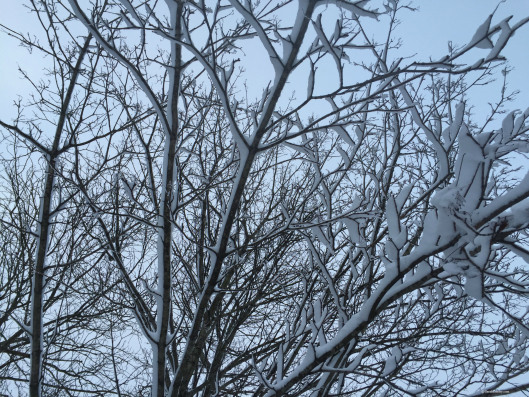
Halifax in the snow. From the first major snowstorm of the year, which hit Nova Scotia earlier this week.
The pride of thine heart hath deceived thee. — Obadiah 3 (KJV)
Pride refers to an inflated sense of self and it’s a major theme in Jane Austen’s novels. It can blind characters to the truth and make them less likeable. In Chapter 7 of Emma, Emma Woodhouse’s interpretation of Robert Martin’s letter to Harriet Smith and her poor judgement of character are strongly influenced by the blinding power of pride.
After Mr. Martin sends a fine, well-crafted proposal of marriage to Harriet, Emma’s “disposition to think a little too well of herself” (Chapter 1) takes over. She is suddenly unable to see clearly. She does see that the letter is one of quality, but she cannot see that the writer of the letter is a person of quality. She persuades Harriet to refuse Mr. Martin’s proposal.
This is the first time I truly dislike Emma. I cannot help but dislike her as she blatantly takes someone’s future into her own hands and handles it badly. She treats both Harriet and Mr. Martin as pawns, without the slightest concern as to the consequences of her misguided advice. Emma believes she cannot make a mistake, and in this belief she reminds me very much of Lady Russell in Persuasion, who persuades a young Anne Elliot to give up Frederick Wentworth. Like Emma, Lady Russell is a woman of good taste, but she is blinded by pride:
She was a benevolent, charitable, good woman, and capable of strong attachments; most correct in her conduct, strict in her notions of decorum, and with manners that were held a standard of good-breeding. She had a cultivated mind, and was, generally speaking, rational and consistent—but she had prejudices on the side of ancestry; she had a value for rank and consequence, which blinded her a little to the faults of those who possessed them. (Chapter 2)
Emma, like Lady Russell, goes through life seeing (and judging) people as she chooses to see (and judge) them. The scene in which Emma attempts to draw a portrait of Harriet offers a good example of the difficulty she has in seeing and accepting things as they are. “You have made her too tall, Emma,” says Mr. Knightley (Chapter 6). Mr. Knightley, aptly named, is the only person who speaks truth without distorted perception.
Over and over again, we see examples of Emma’s blindness. She’s unable to see Mr. Martin’s good qualities or Harriet’s faults; she’s unable to see Mr. Elton’s infatuation with her and lack of infatuation with Harriet. She is also completely blind to the romance between Jane Fairfax and Frank Churchill—granted, so are most readers—and even blind to the fact that she is in love with Mr. Knightley. Shouldn’t a young woman who is “handsome, clever, and rich, with a comfortable home and happy disposition” be able to see things more clearly?
On the very first page of Emma, Austen finishes her initial description of Emma with a hint that—for Emma—things are never what they seem. “Emma Woodhouse, handsome, clever, and rich, with a comfortable home and happy disposition, seemed to unite some of the best blessings of existence, and had lived nearly twenty-one years in the world with very little to distress or vex her” (emphasis added).
Austen tells us right from the beginning that Emma is a heroine with faults that she is unaware of: “The real evils indeed of Emma’s situation were the power of having rather too much her own way, and a disposition to think a little too well of herself…. The danger, however, was at present so unperceived, that they did not by any means rank as misfortunes with her” (Chapter 1).
Mr. Knightley tries to reason with Emma. He sees people for who they are and is frustrated when Emma becomes delusional. When Emma announces that Harriet has refused his good friend Mr. Martin, he objects strongly.
“Not Harriet’s equal!” exclaimed Mr. Knightley loudly and warmly; and with calmer asperity, added, a few moments afterwards, “No, he is not her equal indeed, for he is as much her superior in sense as in situation. Emma, your infatuation about that girl blinds you. What are Harriet Smith’s claims, either of birth, nature or education, to any connection higher than Robert Martin?” (Chapter 8)
I must add that I have wondered if it was actually Mr. Knightley who wrote the letter to Harriet for Mr. Martin (just as Emma dictates a response for Harriet). But then, I wonder if I am being a bit Emma-like in doubting Mr. Martin’s capabilities.
Thankfully, all turns out for the best. Harriet does not seek Emma’s advice when Mr. Martin proposes a second time (just as Anne Elliot does not seek Lady Russell’s advice the second time around). They have all learned from their mistakes. Emma, reluctant to admit her mistakes, finally realizes how dangerous pride can be:
Emma was quite relieved, and could presently say, with a little more composure, “You probably have been less surprized than any of us, for you have had your suspicions.—I have not forgotten that you once tried to give me a caution.—I wish I had attended to it—but—” (with a sinking voice and a heavy sigh) “I seem to have been doomed to blindness.” (Chapter 49)
Emma’s feelings are similar to Lady Russell’s at the end of Persuasion, in a passage where Captain Wentworth’s name could easily be replaced with that of Mr. Martin (and Mr. Elliot’s with that of Mr. Elton):
She must learn to feel that she had been mistaken with regard to both; that she had been unfairly influenced by appearances in each; that because Captain Wentworth’s manners had not suited her own ideas, she had been too quick in suspecting them to indicate a character of dangerous impetuosity; and that because Mr. Elliot’s manners had precisely pleased her in their propriety and correctness, their general politeness and suavity, she had been too quick in receiving them as the certain result of the most correct opinions and well-regulated mind. (Chapter 24)
The blinding power of pride is an essential ingredient in Austen’s novels. It causes characters in books—as in real life—to make poor decisions, many of which have severe consequences for others. In Austen’s novels I am grateful for second chances and the opportunity for characters to come to a greater understanding of their mistakes. I only wish that, in this regard, life could be more like an Austen novel.
Quotations are from the Everyman’s Library edition of Emma (1991) and the Dover edition of Persuasion (1997).
Eighth in a series of blog posts celebrating 200 years of Jane Austen’s Emma. To read more about all the posts in the series, visit Emma in the Snow. Coming soon: guest posts by Diana Birchall, Carol Chernega, and Janet Todd.
Subscribe by email or follow the blog so you don’t miss these fabulous contributions to the celebrations! And/or follow along by connecting with me on Facebook , Pinterest , or Twitter ( @Sarah_Emsley ).


January 13, 2016
Emma Woodhouse as a Spiritual Director
Maggie Arnold is an Episcopal priest in the Diocese of Massachusetts, currently serving as Assistant Rector at Grace Church, Medford. She wrote about the process of discerning a religious vocation in Mansfield Park for the celebration I hosted in 2014 in honour of the novel’s 200th anniversary, and for today’s Emma in the Snow guest post, she’s written about Emma’s efforts at guiding and shaping Harriet Smith’s character and actions.
 Maggie holds a Ph.D. in Religious and Theological Studies from Boston University and she’s currently revising her dissertation, “Mary Magdalene in the Era of Reformation,” for publication. Her research interests include early modern women and religion, and the intersection of religion and art. She also has an MFA from the University of the Arts in Philadelphia, specializing in the art and history of the book form. Maggie grew up in Halifax—she and I read Pride and Prejudice together in our high school English class—and she currently lives in Brookline, Massachusetts.
Maggie holds a Ph.D. in Religious and Theological Studies from Boston University and she’s currently revising her dissertation, “Mary Magdalene in the Era of Reformation,” for publication. Her research interests include early modern women and religion, and the intersection of religion and art. She also has an MFA from the University of the Arts in Philadelphia, specializing in the art and history of the book form. Maggie grew up in Halifax—she and I read Pride and Prejudice together in our high school English class—and she currently lives in Brookline, Massachusetts.
I didn’t add any photos of snow to last week’s guest posts on food, although my husband, after he read Dan Macey’s post on “Discovering Mutton in Emma,” very thoughtfully sent me a photo of a cover for Sheep Industry News featuring sheep in the snow— with “Mutton in the Snow” as the email subject line. Since we’re setting mutton and gruel aside for the moment (we’ll come back to the strawberry-picking scene and other food-related topics in Emma later in the series), for Maggie’s guest post on spiritual direction I thought I’d choose a photo that includes some snow. It’s hard to photograph “spiritual direction”—and I don’t have any photos of “Spiritual Directors in the Snow”—so I decided on a picture I took when I was in Calgary last month, of the view from the Peace Bridge, because I liked the connection between the themes of spiritual guidance and peace.
First, here’s the bridge itself:
Here’s the view of the ice and snow on the Bow River:
And here’s what Maggie says about Emma as a spiritual director:
Emma Woodhouse makes a series of experiments in directing the development and conduct of her protégé, Harriet Smith, all of which end disastrously. Her inclination for these projects may have been formed through a youth in which she had to manage her father’s many anxieties in order to achieve domestic harmony and a measure of freedom for herself. And, as she herself admits, she takes credit for the successful match between her governess, Miss Taylor, and Mr. Weston. So both long habit and recent encouragement have prepared Emma to try her skills with a new subject.
The formation and guidance of another’s character and actions have a long history in the Christian tradition, as the practice of spiritual direction. This kind of pastoral care began with the Desert Fathers and Mothers of fourth-century Egypt, and evolved through medieval Benedictine and Cistercian monastic culture, and the Jesuit confessors of the Catholic Reformation. The practice also continued in Protestant communities, in which the laity were empowered to offer one another counsel through mutual study of the Bible and other devotional works. Spiritual direction today draws on this heritage and incorporates insights from contemporary psychology. Typically, a person contemplating a decision or seeking a mentor will approach an authoritative figure, someone known for wisdom and experience in prayer and discernment. (For one such process, see the first chapter in The Lived Experience of Spiritual Direction, edited by Rose Mary Dougherty.) The counseling relationship usually consists of conversations, with assignments of particular tasks in between these, perhaps reading and different kinds of work, self-discipline, prayer, or imaginative contemplation.
Emma’s failures with Harriet serve as a comic illustration, by counter-example, of many of the ideals of spiritual direction. The irony is that Emma claims, to herself and others, to be following traditional principles of spiritual direction: the formation of another for making good decisions, elucidating the directee’s own God-given gifts. As she selects Harriet for improvement, Emma’s professed goal is “decision of character” (Chapter 6). Her intention is to educate Harriet by conversation and instructive reading. Emma maintains that she will merely draw out what is naturally good in Harriet, rather than influencing or altering her behaviour unduly. Both Emma and Harriet herself acknowledge that it is Harriet’s own decisiveness that is desirable. When Harriet is desperate for advice on how to reply to Robert Martin’s first proposal, Emma ostensibly refuses, “Oh, no, no; the letter had much better be all your own,” and Harriet eventually admits that “one’s mind ought to be quite made up” (Chapter 7). Of course, as the reader observes in their exchange, Emma actually manipulates Harriet into crafting the response of Emma’s choice.
After the initial mistake over Mr. Elton’s feelings, Emma gradually learns to become more impartial and attentive to Harriet’s own needs. She realizes that she has been too “active” (Chapter 16) in trying to bring Mr. Elton and Harriet together. The next time Harriet has a crisis, Emma attempts to be supportive, rather than directive: “Emma felt that she could not now show greater kindness than in listening” (Chapter 21). As Kathleen Fischer claims in Women at the Well: Feminist Perspectives on Spiritual Direction, “the skill of listening is the basis for spiritual companionship.” Listening is Emma’s counsel to Harriet when Harriet is again in love; Harriet should watch and interpret others with sensitivity and caution (Chapter 40). As Emma becomes less confident of her own powers, she also comes to appreciate Harriet’s own character, asserting that Harriet’s open and affectionate nature is more to be prized than a readily judging intellect (Chapter 31). This shift from a directive to a companionate model agrees with the arc described by Carolyn Gratton in The Art of Spiritual Guidance: “we need meditative hearts, and hearts do not get that way by conceptualizing or analyzing.”
In addition to the effect of painful mistakes, Emma learns about spiritual direction from two examples, one positive and one negative. Mr. Knightley presents several ideals for offering good guidance. He speaks clearly in determining the needs of others, and helps Emma to do so, as when their simple communication prepares for Mr. Woodhouse’s quick departure from a dinner party on a snowy night. (Nora Bartlett and Deborah Knuth Klenck have also discussed this brief conversation in their guest posts for “Emma in the Snow.”) When he criticizes Frank Churchill’s confusing behaviour, Mr. Knightley confirms that consistency and honesty are his own principles, noting their power to impress and persuade others (Chapter 18). Mr. Knightley is true to himself, and knows that is the only way to engage others with integrity. Mrs. Elton, by contrast, shows Emma a repugnant example of someone who is overbearing and insensitive, with her tone-deaf meddling in Jane Fairfax’s affairs. Mrs. Elton ignores Jane’s expressed preferences—to collect her own mail and to choose her time to apply for employment—and instead decides what is best for her (Chapters 34 and 35).
Not only does Emma turn from her previous approach to managing Harriet’s romantic hopes, she gains self-awareness by applying the principles of spiritual direction and discernment to her own life. She begins haltingly, trying to assess her emotions about Frank Churchill. Reflection on one’s desires as a means of deliberation is a legacy of the Ignatian examen, the Jesuit practice of daily self-interrogation. Emma ultimately decides that Frank’s character, unlike her own, is not really worth a serious attempt at understanding and judgment. Because she does not intend to marry Frank, she need not evaluate his character, but she recognizes that an accurate self-knowledge is crucial for right action.
By the conclusion of the story, Emma has arrived at a true and humble self-assessment. She agrees with Mr. John Knightley, that “the good fortune of the engagement” between her and Mr. Knightley is all on her side, though she hopes to become better by further study (Chapter 53). The prospect bodes well, for her new insight has already prompted kinder treatment of Miss Bates, a growing friendship with Jane Fairfax, and a marriage of, as Mr. Knightley proclaims, equal worth and happiness.
Sources
Austen, Jane. Emma. New York: Bantam Classics, 1981.
Dougherty, Rose Mary, ed. The Lived Experience of Spiritual Direction. New York: Paulist Press, 2003.
Fischer, Kathleen. Women at the Well: Feminist Perspectives on Spiritual Direction. New York: Paulist Press, 1988.
Gratton, Carolyn. The Art of Spiritual Guidance: A Contemporary Approach to Growing in the Spirit. New York: Crossroad, 1993.
Ignatius of Loyola. Spiritual Exercises and Selected Works. Edited by George E. Ganss, S.J. The Classics of Western Spirituality. New York: Paulist Press, 1991.
Seventh in a series of blog posts celebrating 200 years of Jane Austen’s Emma. To read more about all the posts in the series, visit Emma in the Snow. Coming soon: guest posts by Mary C.M. Phillips, Diana Birchall, and Janet Todd.
Subscribe by email or follow the blog so you don’t miss these fabulous contributions to the celebrations! And/or follow along by connecting with me on Facebook, Pinterest, or Twitter (@Sarah_Emsley).


January 8, 2016
Why Mr. Woodhouse Takes Care About What His Guests Eat
 Catherine Morley describes her research as the study of “people and their relationships with and through food.” Like Dan Macey, who wrote about “Discovering Mutton” for my Emma in the Snow series earlier this week, she’s interested in what Jane Austen says about food in her novels. Ever since Catherine read Emma for the first time, she has, she says, “been intrigued with Mr. Woodhouse’s beliefs about food, beliefs so strong that he tries to influence the food intakes of others.” It’s a pleasure to introduce her guest post on the way Mr. Woodhouse understands food in relation to the four humours.
Catherine Morley describes her research as the study of “people and their relationships with and through food.” Like Dan Macey, who wrote about “Discovering Mutton” for my Emma in the Snow series earlier this week, she’s interested in what Jane Austen says about food in her novels. Ever since Catherine read Emma for the first time, she has, she says, “been intrigued with Mr. Woodhouse’s beliefs about food, beliefs so strong that he tries to influence the food intakes of others.” It’s a pleasure to introduce her guest post on the way Mr. Woodhouse understands food in relation to the four humours.
Catherine is registered as a Professional Dietitian in Nova Scotia and she holds the Fellow of Dietitians of Canada designation. She’s an Assistant Professor in the School of Nutrition and Dietetics at Acadia University in Wolfville, Nova Scotia, and an Adjunct Professor in Applied Human Nutrition at Mount St. Vincent University in Halifax. Before moving to Nova Scotia in 2011 and joining our local JASNA group, she was a member of JASNA Vancouver for several years. Prior to that, she was a founding member of the JASNA Calgary Region.
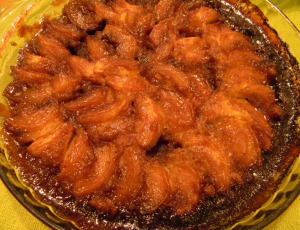
Catherine’s photo of apple cake
I have heard Mr. Woodhouse described as a hypochondriac, and have on several occasions been asked by JASNA members about what sort of digestive disorder I thought Jane Austen might have attributed to Mr. Woodhouse (such as, did he have an ulcer or irritable bowel syndrome?). I do not think of Mr. Woodhouse as hypochondriacal; rather, I think that it is through his character that Jane Austen conveyed what would have been common beliefs about diet and the potential of diet to influence health, and that she was poking fun at a type of person that most everyone would have known.
Exploring the invalid’s dietary
As a Visiting Fellow (2010) and Visiting Researcher (2012) at Chawton House Library I studied the collection of cookery books and books related to medicine and health for insights into feeding the sick in the time of Jane Austen. I furthered this research by collecting and studying early dietetics reference texts (1875 to 1910) that preceded the origins of the profession of dietetics. Through to 1910-1920 or so, dieticians were physicians who specialized in diet therapy (hence the spelling variant using a “c” in the final syllable—as in the spelling of physician—that is carried over in the UK spelling today). Dietetics as a profession separate from medicine developed in Canada in the late 1910s; university programs were established in the 1920s and 1930s in each province. This history is important when one considers that therapies for ailments during Austen’s time (and more or less through to the 1940s) generally consisted of the administration of alcohol, opioids, herbs, and food.
Mr. Woodhouse (as with Jane Austen and her contemporary readers) would have been familiar with beliefs about food choices to balance the humours. Foods were considered cooling or heating, and drying or moistening (see the table below). Thus, there were four categories of food: cool/dry; cool/moist; hot/dry; and hot/moist. This categorization (hot/cool/dry/moist) had nothing to do with the physical properties of foods, but rather with effects they were believed to have on the humours.
The four humours (simplified) (adapted from Keirsey D. [1998])
Recipes contained descriptors of foods, ingredients, or the dish overall (e.g., “this is cooling” or “this is dessicating [drying]”). The use of these descriptors without providing definitions of the terms implies that this knowledge was commonly held and needed no explanation.The food Mr. Woodhouse offers his guests
In Volume 1, Chapter 3 of Emma, the Woodhouses are entertaining guests including Mrs. Bates, Miss Bates, and Mrs. Goddard. Mr. Woodhouse demonstrates concern for the health of his guests through the attention he pays to the foods he offers and to whom. There is much more meant by these offers than merely being hospitable. We no longer hold the same beliefs about foods or about how to balance the humours (or even believe that there are such things as humours), which makes it harder to understand what Mr. Woodhouse means by his offers of food and drink for his guests.
The passage reads,
Upon such occasions poor Mr. Woodhouse’s feelings were in sad warfare. He loved to have the cloth laid, because it had been the fashion of his youth, but his conviction of suppers being very unwholesome made him rather sorry to see any thing put on it; and while his hospitality would have welcomed his visitors to every thing, his care for their health made him grieve that they would eat.
Such another small basin of thin gruel as his own was all that he could, with thorough self-approbation, recommend; though he might constrain himself, while the ladies were comfortably clearing the nicer things, to say: “Mrs. Bates, let me propose your venturing on one of these eggs. An egg boiled very soft is not unwholesome. Serle understands boiling an egg better than any body. I would not recommend an egg boiled by any body else; but you need not be afraid, they are very small, you see—one of our small eggs will not hurt you. Miss Bates, let Emma help you to a little bit of tart—a very little bit. Ours are all apple-tarts. You need not be afraid of unwholesome preserves here. I do not advise the custard. Mrs. Goddard, what say you to half a glass of wine? A small half-glass, put into a tumbler of water? I do not think it could disagree with you.”
The foods that Jane Austen selected for Mr. Woodhouse’s offers were not random—she carefully chose them based on well-understood beliefs about ordering the humours. Here are some excerpts from The Family Magazine (1792) related to the foods Mr. Woodhouse mentions, and my thoughts on what he might have meant by offering the foods he did.
Food item: Gruel (I presume this is oatmeal gruel, though it can be made from any grain)
For whom: Himself (an elderly man with a fear of illness)
Information taken from The Family Magazine (1792): “Oatmeal is the wholesomest of all grain. It is a light opening diet, and passes thro’ all the capillaries or small vessels without stopping ’em up. ’Tis good for asthmatical and phthisical [wasting] people because it brings up their phlegm. ’Tis also good in vaporous constitutions, because it smooths and licks up the sharp humour in the bowels of such. Oatmeal and butter dry the scab on the head. Outwardly applied” (II, 6).
My comment: Oatmeal was considered to have valuable qualities and was seen as useful in balancing the humours for those with lung conditions, gut disorders (“vaporous” refers to gas producing), and wasting or consumptive disorders. Consumption was any condition where there was fast and extreme weight loss, not limited to pulmonary tuberculosis, and might have included cancers, diabetes, renal failure, liver failure, and lung disorders. Given this inventory of benefits, it is no wonder Mr. Woodhouse places such value on gruel.
Food item: Eggs (one egg, actually)
For whom: Mrs. Bates (an elderly woman)
Information taken from The Family Magazine (1792): “Eggs are said to be the most nourishing and exalted of all animal food” (II, 4).
My comment: Eggs were considered neutral; not heating. A risk-free, sensible choice for an elderly woman.
Food item: Apple
For whom: Miss Bates (a middle-aged woman)
Information taken from The Family Magazine (1792): “Apples cool and loosen, and help the appetite, but are not good for cold stomachs. They have given more help to scorbutick or splenetick patients (especially such that were of a hot, dry constitution, and apt to be costive), than anything else the shops or field could furnish out” (II, 9).
My comment: Perhaps Mr. Woodhouse thinks she is costive (constipated) and that consuming some apple would be of benefit? Perhaps he thinks her humours are too hot and need cooling. Likely the apples come from Donwell Abbey and are highly trusted.
Scorbutick means: scurvy/vitamin C deficiency (although vitamins were not yet known in the 1800s).
Spenetick means: might mean to have a disorder of the spleen (see the table above), or to be spiteful, irritable, or bad tempered. If the former, this explains why apples would “not be good for cold stomachs” (a humoural reference, not a physical state).
Food item: Pye (pie or tart)
For whom: Miss Bates
Information taken from The Family Magazine (1792): “Greasy and doughy pye crust seems to be no very digestible food, especially to weak stomachs” (II, 6).
“Pyes made of any kind of Flesh-meats are strong food; and by reason of the seasoning, generally too pernicious to health to be indulged to valetudinary constitutions” (II, 3).
My comment: Pastry was dangerous—made moreso when filled with meat. Mr. Woodhouse perhaps balances the benefits of apples with the potential harm from pastry such that he can safely recommend a little bit of apple tart to Miss Bates (not too much as that would not be safe), her constitution being strong enough to deal with the potential harm from piecrust.
Food item: Wine
For whom: Mrs. Goddard
Information taken from The Family Magazine (1792): “The usual draught for ailing people, when the case forbids it not, may be ripe red French-wine, thrice or four times a day, to the quantity of half an ounce” (II, 4).
“Wine of all sorts will heat and inflame, some are pectoral, some heady, some griping. All new wines are laxative and windy. White wines are generally more inflaming than red. Old wines are warmest and most comforting. Rhenish wine is the least heating, but most dangerous with us, being adulterated by drugs of pernicious qualities, to restore it when eager. Sweet wines nourish most, but affect the head and stomach, and occasion viscosities. Small wines hurt the membranous parts and nerves. But after all, good wine, moderately taken, and used discreetly as to its relative qualities with the subjects taking it, is a cordial. But it is so difficult to meet with it unadulterated, that the less generally it is drank, the better” (II, 4).
My comment: What sort of wine is Mr. Woodhouse offering? Regardless of the type, it would be heating and perhaps dangerous to the balance of Mrs. Goddard’s humours, unless he thinks she is too cool and would benefit from more balance. Perhaps he suggests diluting the wine with water so he won’t alarm Mrs. Goddard or anyone else listening in—so they won’t think he is worried about her humours being out of balance. He definitely thinks she could benefit from the stimulating effects of the wine.
“I do not think it would disagree with you” would refer to the wine producing too much heat and therefore presenting a different kind of danger.
Food item: Custard
For whom: Not recommended for any of the guests
Information taken from The Family Magazine (1792): No description of the benefits or risk of custard are given. Here, though, is a recipe:
“A quart of cream or new milk, and a stick of cinnamon, four laurel leaves, and some large mace, boil them altogether, take twelve eggs, beat them well together, and mix them with sugar and canary, till a white scum arises, skim it off. Then, the coffins [pastry shells] being first dried in the oven, fill them” (I, 63).
My comment: The value Mr. Woodhouse puts on eggs and the warning about custard have always puzzled me, given that eggs were considered “an exalted animal food.” Why would he not recommend the custard? None of the custard ingredients were risky, according to The Family Magazine. Perhaps he knows something about the milk used to make it; that is, it is not from his or Mr. Knightley’s dairy and therefore cannot be trusted. Perhaps the custard has not been made by Serle. Or perhaps the custard is leftover and no longer considered safe. As an egg-based dish, it would normally be considered “wholesome” (that is, something that contributes to balancing the humours).
Food item: Cream, butter, and marrow (the first two, as custard ingredients. It’s curious that marrow is grouped with cream and butter)
For whom: Not recommended
Information taken from The Family Magazine (1792): “Are all lenient and nourishing” (II, 4).
My comment: There is nothing worrisome here about these ingredients. Cream or butter might have been ingredients in the custard Mr. Woodhouse does not recommend. Also, perhaps, in the tart? So it seems not to have been the eggs, cream, or butter that Mr. Woodhouse did not trust—perhaps, then, it is something about who has made it. Concern about how long it has been in the house seems unlikely since food safety, as we think of it today, was of little concern, given the practice of painting old meat with fresh blood in markets or of adding chalk to flour to make bread appear whiter, or to watered-down milk to make it go further, and so on.
“Lenient” refers to adding moisture, so recommended where dry humours were concerned.
Food item: Milk (as an ingredient in custard)
For whom: No one; the custard is not recommended
Information taken from The Family Magazine (1792): Aliment categories listed in order are Meats, Drinks (waters, whey, coffee, tea, chocolate, wine, cyder, perry, brandy), Grain, Pulse, Nuts, Roots, Herbs, Fruits, Aromatrick Herbs, Plants, and Spices (II).
My comment: Milk is not included in the section on aliments (food) in The Family Magazine. I wonder if this means that milk was not considered a food or thought of as offering any nourishment. It is curious that it is absent, and equally curious that cream, with its origins from milk, is grouped with butter and marrow (which were considered cooking fats or spreads).
Given what people thought at the end of the 18th century about food and its effects on the humours, two observations can be made:
When reading the novels, we can’t connect the foods that Jane Austen included in her novels with anything we know or believe about foods today. There was, at the time, no knowledge of nutrients, of humans’ nutrient needs, or of the nutrient composition of foods (how much of what food is sufficient to meet nutritional requirements).
Jane Austen may have been poking fun at people who had “old-fashioned” ideas about the effect of food on the humours. My rationale for this statement relates to newer ideas emerging in the late 18th century about applying scientific thought to considerations of health. One of these new ideas was that of “rational cookery” or “the rational diet.”
What Jane Austen might have known about the rational diet
The Cook Not Mad; or Rational Cookery, published by James Macfarlane in 1831 in Kingston, Upper Canada, was the first cookbook published in Canada, a “Canadianized” version of an American book by the same name. The entire title was:
The Cook Not Mad; or Rational Cookery: Being A Collection of Original and Selected Receipts, Embracing not only the art of curing various kinds of Meats and Vegetables for future use, but of Cooking in its general acceptation, to the taste, habits, and degrees of luxury, prevalent with the Canadian Public, To Which Are Added, Directions for preparing comforts for the SICK ROOM—together with sundry miscellaneous kinds of information of importance to housekeepers in general, nearly all tested by experience.
The Canadian version was a near reprint of the American version, which itself was likely composed of material from cookery books originating in England. Roy Abrahamson, the editor of the 1972 reprint of the 1831 version, claims that “While most cook or household books of the period were derived from English works, The Cook Not Mad breaks with this tradition and is definitely a North American cookbook.” Abrahamson’s assertion was owing to the use of what he refers to as “indigenous ingredients” (turkey, oysters, cod, pidgeons, cranberries, corn, pumpkin, molasses, watermelon). However, given that plants, seeds, food, drink, and livestock had been crisscrossing the Atlantic Ocean for over 300 years when the book was published in 1831, these “indigenous foods” would have been known in England. In addition, cod, oysters, pidgeons, and molasses did not have to be introduced to Europe. While the fish, shellfish, and bird were native to Northern Europe, including England, molasses had been available in Europe since 1582. The second point to refute this claim is that the receipts (recipes) contained in The Cook Not Mad, especially those relating to care of the sick, are consistent with those in English cookery books dating from 1641 that I studied at Chawton House Library. Thus, the idea of “rational cookery” likely had its origin in Europe or England, and it was an idea that I think was familiar to Jane Austen. Here’s why.
Jane Austen and the rational diet
In The Cook Not Mad, the intent of rational cookery is described as:
… a system of Cookery which has for its main object the health of its friends. Temperance in the quality and quantity of our diet contributes more to our health and comfort than we are aware of. It was the remark of an eminent physician upon the inquiries of a patient, “that it was of less importance what kind of food we ate, than the quantity and the mode of its preparation, for the stomach.” … The health of a family, in fact, greatly depends upon its cookery. The most wholesome viands may be converted into corroding poisons. (Preface)
Important here is the use of the word “health,” with no mention of the humours or efforts to bring them into balance. This was the beginning of what has become known as the science of nutrition (where the nutritional properties of foodstuffs are known and these are recommended relative to the nutrient needs of a person or population defined by age and, for some nutrients, by sex, and these are considered in terms of the composition of and amount of foodstuffs taken). I believe Jane Austen was aware of and attended to the precepts of rational cookery owing to three sentences written in her letters between January and May of 1817, the latter written less than two months before her death. It seems that while she may have viewed dietary manipulations in a more scientific way, she retained some belief in the categorization of diseases relative to the humours. Her diagnostics appear to be rooted in traditional thinking about disease while she looked to new ways of thinking about diet in composing her treatment plans.
The first of these excerpts is from 24 January 1817 to her friend, Alethea Bigg:
I have certainly gained strength through the Winter & am not far from being well; & I think I understand my own case now so much better than I did, as to be able by care to keep off any serious return of illness. I am more and more convinced that Bile is at the bottom of all I have suffered, which makes it easy to know how to treat myself. (Italics added)
In this letter, Austen identifies problems with bile at the root of her problems. Which did she mean, yellow bile or black bile? (See the table above.) I think she meant yellow bile, owing to her letter of 6 April 1817 to her brother, Charles Austen: “I have been suffering from a Bilious attack, attended with a good deal of fever.”
In the Glossary of Medical Terms Used in the 18th and 19th Centuries, biliousness is defined as “nausea, abdominal pains, headache, and constipation. Also jaundice associated with liver disease.”
An imbalance of yellow bile made a person choleric; a person with this condition was considered to be hot and dry, and their illness involved the gall bladder. (This is not the way we think of the gall bladder and its function in 2016.) Black bile imbalance was considered to be melancholia with problems with the spleen (cool and dry). Since Austen refers to fever (therefore “hot”), of the two types of bile, I conclude hers was a problem of yellow bile (black bile does not actually exist). These two ideas together would indicate Jane Austen had digestive complaints. What we do not know is whether by fever she meant elevated body temperature, that she thought her humours were too hot, or something else. Fever was a catch-all term for a variety of complaints, and meant that the humours were too hot. About fever:
And as it is a distemper of the utmost consequence, and such as ought to be critically attended to, we shall trace it as briefly as possible from its beginning, whether it proceeds from cold (as is generally the case), or from heat, and incautious drinking to quench the thirst occasion’d thereby, whereby dangerous inflammations, etc. proceed. And, above all, shall be careful to give no direction, but what is the result of experience practice in so hazardous a case, that so such as have not an opportunity to consult a skilful physician, may not be lead into mistakes, where the consequence may be so fatal. (Family Magazine, Part II)
Interesting in the letter from 24 January 1817 is the phrase, “which makes it easy to know how to treat myself.” This idea indicates either that Austen had knowledge of foods to eat to balance humours and to treat or prevent biliousness, or that she was applying emerging scientific principles about diet to treat her condition. It is in her letter of 27 May 1817 to her nephew, James Edward Austen, where she reveals her familiarity with the idea of rational cookery; that is, that she was applying early ideas about the science of nutrition to what and how she ate. She writes,
I will not boast of my handwriting; neither that, nor my face have yet recovered their proper beauty, but in other respects I am gaining strength very fast. I am now out of bed from 9 in the morng to 10 at night—Upon the Sopha ’tis true—but I eat my meals with Aunt Cass; in a rational way, & can employ myself, & walk from one room to another. (Italics added)
In using the phrase, “in a rational way,” Austen reveals that she and her nephew (and presumably her sister, Cassandra) were familiar with the ideas of the rational diet or rational cookery. Curiously, the receipts given in The Cook Not Mad (1831) are exactly those given in cookery books that predate it. Even more curiously, these same recipes were included in The American Woman’s Cookbook (1956). My interpretation is that the language used to describe ideas about diet changed but the foods actually recommended and consumed did not.
Returning to Mr. Woodhouse
To return to Jane Austen’s use of Mr. Woodhouse’s food suggestions for his guests: when I read the novels, I do so with the idea that the author was very familiar with traditional humour-based ideas about diet, as she was aware of emerging ideas about the science of nutrition. Further, I think she would have known that many of her readers would likewise feel caught between older and newer ways of thinking about food and diet, and could relate to the confusion about what to believe about diet—something we continue to experience (which has been termed “dietary cacophony” by food sociologist Claude Fischler). Lastly, I think her inclusion of this passage was for comedic effect. I suspect she recognized that many of her readers would recognize themselves and their own worries about how food intakes affected the balance of the humours, as well as this concern in others among their friends and family. Perhaps she was even thinking of her own health.
Two important considerations related to food, diet, nutrition, and health when reading Austen’s novels (or any novels written before about 1920): we need to keep the idea of “balancing the humours” in mind, recalling that illness was ever-present during Austen’s time and remembering not to think about food and nutrition using today’s notions of diet and health, and we need to remember that people did not yet know how to treat even simple maladies according to today’s standards. Thus, a common cold, the measles, or food poisoning could have been fatal. People had good reason to think constantly about minimizing any harm that might arise from food consumption that could disorder the harmony of the humours, and about how to bring the humours back into balance.
Sources
Austen, Jane. (1995). Emma. New York: Oxford.
Anonymous. (1831). The Cook Not Mad, or Rational Cookery; Being A Collection of Original and Selected Receipts, Embracing Not Only the Art of Curing Various Kinds of Meats and Vegetables for Future Use, but of Cooking in its General Acceptation, to the Taste, Habits, and Degrees of Luxury, Prevalent with the American Publick, in Town and Country. To Which are Added, Directions for Preparing Comforts for the SICKROOM; Together with Sundry Miscellaneous Kinds of Information, of Importance to Housekeepers in General, Nearly All Tested by Experience. Watertown, NY: Knowlton & Rice.
Berolzheimer, R. (1956). The American woman’s cook book. Chicago, IL: Culinary Arts Institute.
Kiersey, D. (1998). Please understand me ii: temperament, character, intelligence. Toronto, ON: Prometheus Nemesis Book Co. and the University of Toronto Press.
Le Faye, D. (Ed.) (1995). Jane Austen’s Letters (3rd edition). New York: Oxford University Press.
Macfarlane, J. (1831). The cook not mad; or rational cookery. Kingston, Upper Canada.
The Family Magazine: in two parts. I. Containing useful directions in all the branches of house-keeping and cookery. II. Containing a compendious body of physic; explaining the virtues of all sorts of meats. The second edition. (1792). London: J Osborn at the Golden-Ball in Pater-noster Row.
Sixth in a series of blog posts celebrating 200 years of Jane Austen’s Emma. To read more about all the posts in the series, visit Emma in the Snow. Coming soon: guest posts by Maggie Arnold, Mary C.M. Phillips, and Diana Birchall.
Subscribe by email or follow the blog so you don’t miss these fabulous contributions to the celebrations! And/or follow along by connecting with me on Facebook , Pinterest , or Twitter ( @Sarah_Emsley ).


January 6, 2016
Discovering Mutton in Emma: The Quest to Please the Principals’ Palates
Today’s guest post for Emma in the Snow includes three recipes created by Dan Macey of Dantasticfood, and thus we turn from last Friday’s focus on friendship to this week’s focus on food in Jane Austen’s fiction. For this coming Friday, Catherine Morley has written about Mr. Woodhouse’s knowledge of the four humours in relation to his ideas about food. Today, I’m delighted to introduce Dan’s guest post on mutton in Emma.
Dan is a commercial food stylist, recipe developer, and writer about foodways, the study of the cultural, social, and economic practices related to the production and consumption of food. He recently contributed to Savoring Gotham: A Food Lover’s Companion to New York City, which was published in December by Oxford University Press. He sits on the board of the Historic Foodways Society of the Delaware Valley, is a life member of JASNA, and edits Bits & Scraps, the newsletter for JASNA’s Eastern Pennsylvania Region. (He also prepared an amazing and memorable dinner for the Region’s Board members and their spouses when I visited Philadelphia last summer to give a talk on “Austen and Ambition.”) Please let us know if you decide to try one or more of the recipes he includes here.
People find satisfaction in reading Jane Austen for a myriad of reasons. I read Austen for her reliable and disciplined references to the foodways of her time. I am not alone. Food historians often cite Austen as a source. In both her personal letters and novels, Austen’s descriptions of how food was consumed and perceived give unique insights into the diet and dietary customs of the late eighteenth and early nineteenth centuries. Emma contains the most food references of any of her novels and food may be considered as a metaphor for human interdependence, central to the novel (see Jane Austen and Food, by Maggie Lane [1995]). Dinner provides Emma Woodhouse with useful opportunities for matchmaking. In the first chapter, George Knightley admonishes Emma to “invite [Mr. Elton] to dinner … and help him to the best of fish and chicken, but leave him to chuse his own wife.” Luckily for readers, Emma does not heed Knightley’s advice and the novel continues.
One food mentioned three times in the novel is mutton and this is not by chance. In Volume 1, Chapter 13, Emma meets her brother-law Mr. John Knightley and her nephews “hastening home” on Christmas Eve to eat roast mutton and rice pudding. Later that evening a saddle of mutton is served at the Westons’ dinner party. Maggie Lane suggests Miss Bates may be using the word mutton in a generic sense when she insists on telling people how small a slice of mutton Jane Fairfax eats (Volume 2, Chapter 1). Mutton was a very important food in Austen’s time. Inviting someone to take mutton with you was Regency-era slang for an invitation to dine, says Lane. And because mutton was so ubiquitous, it was often used in jest to mean most certainly dining on something better than mutton. It’s sort of like asking someone today, “do you want to grab a burger or something?”
As a culinary professional who researches and recreates historic recipes, I often have to use modern-day techniques to try to reflect the historic background of a recipe, while making it palatable to today’s modern tastes, and to use ingredients that can be found on today’s grocery shelves. But being a cook with a strong interest in history, I am intrigued by just how mutton would have been served and how it would have tasted. My quest was to make mutton good enough to please Emma, her suitor Mr. George Knightley, and her gruel-eating father. Now, of course, this is a tall order since all three, I presume, have quite different tastes and views on food. So, I decided to create a separate mutton recipe for each of them.
But first, I needed to get a taste for mutton, and a little research was required. While the English traditionally think of themselves as a land of beef eaters, “mutton eaters would be more historically correct,” according to Clarissa Dickson Wright in A History of English Food (2011). The story of sheep and mutton is very much part of the history of the United Kingdom, being entwined with the British landscape, its history, wealth, and wellbeing since prehistoric times. Mutton was commonly found in cookbooks of Austen’s time. Recipes for mutton braised, boiled, roasted with cockles or oysters, marinated, and even kebobbed are all found in one of the more popular cookbooks of the day, The London Art of Cookery, by John Farley, published in 1811. “Mutton is undoubtedly the meat most generally used in families,” noted one nineteenth-century cookbook author. Boiled mutton was the easiest and most popular way to prepare it. Boiled mutton in England in the late 1700s was reportedly boring, gray, mealy, chewy and just tolerable. Boiled mutton was endured more than savored, but because it was meat, it was valued for nutrition. For the very poor, mutton was an aspiration. Period cooks tried to enhance the look of the meat by boiling the mutton in a cloth to give it paler, less gray, color. There is, in fact, a cartoon by Lewis Walpole in which a husband proclaims the meat “not fit to eat,” and grumbles, “these are the blessed effects of boiling Mutton in a cloth!”
But even in Austen’s time, good mutton was available at a price and there were delicious ways to prepare it. In fact, Austen was very proud of the quality of meat her father produced at Steventon. A neighbor “gratified us very much yesterday by his praises of my father’s mutton, which they all think the finest that was ever ate” (Jane at Steventon writing to Cassandra at Godmersham, 1 December 1798).
Today, in England, there is a campaign, led by Prince Charles, to get the British to serve mutton—and not lamb—at their dinner tables. The Mutton Renaissance Campaign aims to support British sheep farmers struggling to sell their older animals. His efforts have led to new definitions for mutton in the country. Mutton now is defined as the meat from a sheep more than two years old, aged for two weeks after slaughter by hanging and traceable to a specific farm where it was fed on forage, rather than a high concentration of grain. Mutton is now turning into an artisanal food and reclaiming its place on the British dinner table.
Mutton Shopping in North Philadelphia
Before I was to devise recipes to please our characters, I had to first find the mutton—something not all that easy to locate in United States. Lamb, mutton’s younger version, is most readily available in many supermarkets, but mutton, the meat from older sheep, has fallen out of favor and is nearly impossible to find in any market. There are the standard complaints of its gamey flavor—apparently caused by fatty acid accumulation that comes with age—and a lack of tenderness. While lamb has always been more popular than its older relative, interest in mutton declined further after canned mutton rations were offered to soldiers in World War II. In researching recipes, I learned that most of the mutton produced in the U.S. is either used for dog food or shipped to Latin America to be used for traditional barbequed dishes. Julia Child, in her Mastering the Art of French Cooking, which was published in 1961, noted that “mutton, though much appreciated flavor, is not popular in America and generally must be specifically ordered.” I found that not much has changed since 1961.
After many internet searches and telephone calls to local butchers and meat purveyors—including wholesalers—my shopping finally concluded with a halal butcher in North Philadelphia. The shop, filled with hand-written signs and nestled on a narrow, nondescript street, was patronized mostly by practicing Muslims and a host of Central and South American immigrants looking for a taste of home. Besides mutton, the shop, Al-Baraka, sells goat meat as well as four kinds of live chickens, ducks, and rabbits. Pens of live chickens and fowl are open for families to peruse and their selection will then be slaughtered for them in the rear of the shop while they wait. The market looked as if it could have been right out of the Regency period, with what appeared to be much haggling and discussions about the best types of bird to use for a recipe. I ordered both a leg of mutton, which the butcher sawed (using an actual band saw) into steaks—something not usually done with a leg of lamb—and a shoulder of mutton, which he cut into pieces.
I learned that the mutton was raised in a manner that would meet the strict requirements of the Prince of Wales. “We are committed to providing a fresh and healthy alternative to supermarket meat and poultry,” reads an advertisement for the butcher. “Our livestock comes from local Pennsylvania small farms in New Holland, which are known for producing higher quality beef, lamb, and goat. This is because the livestock is left to graze on grass, rather than grown in large feedlots. This makes the meat organic, as there are no hormones used to increase the rate of growth of the animals, which means a meat that doesn’t just taste better, but is also healthier.” Words that Mr. Woodhouse himself would, I daresay, approve.
So, I had found my mutton. Now, how to prepare it in a manner to please our characters. For Mr. George Knightley—who I assume would also have rushed home, much like his brother, for good mutton—I decided to prepare my mutton steaks using a recipe for Haricot Mutton found in Martha Lloyd’s Household book as a starting point (see A Jane Austen Household Book with Martha Lloyd’s Recipes, by Peggy Hickman [1977]). Martha Lloyd shared a home with Jane, her sister, and her mother first in Southampton and later at Chawton Cottage. Eleven years after Jane’s death, she married Jane’s brother Admiral Francis Austen. She compiled a book of recipes and household hints gathered during her stay with the Austens. The “haricot” here is in reference to the vegetables, which are cut up into pieces—a term borrowed from the French. During Austen’s time, the mutton would likely have been prepared in a large cast iron skillet or pot hanging over an open hearth or nestled on a stand near the fire, so I prepared the Haricot Mutton in a cast-iron, Dutch oven on a gas stove. I added fennel, replacing the originally called-for turnips which are not very popular in my house (recipe below).
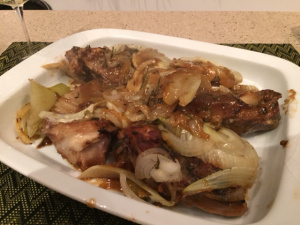
A haricot of mutton
Now, what to make for Emma?
While curries are not mentioned in any Austen novel, curries did exist during her time (and there is one reference in her “Lesley Castle”: “the Curry had no seasoning”). The Betty Crocker of the age, Hannah Glasse, includes one in The Art of Cookery Made Plain and Easy, which was first published in 1746, but ran to another seventeen editions by the end of the century. It is fair to say that the Austen household likely would have had a copy of Glasse’s book. In fact, many of the recipes found in Martha Lloyd’s cookbook can be traced to Hannah Glasse.
A curry may seem a bit out of place for such an English book, but it is noted by Wright, author of A History of English Food, that two of Glasse’s sons made the journey to the subcontinent when the East India Company was at its zenith, “hugely successful, hugely wealthy and hugely corrupt.”
In fact, we know that Jane Austen’s own aunt Philadelphia had ventured to India and may well have talked of the ready-mixed Indian curry spices that were available in England by 1780. Exotic fruits came to England from the East Indies, including mangoes, which Wright says Jane Austen mentions in her letters. (Wright talks about this on two occasions in A History of English Food, but I haven’t been able to find the letter—do any of you know where the reference is?)
An early advertisement in a London newspaper for “the invaluable rich ingredient” brought to England from the exotic East Indies promoted curry as a great ingredient to make “sumptuous sauces.” The advertisement also hailed curry’s health benefits, including good digestion, good circulation, and a “vigorous” mind, and suggested that it “contributes most of any food to an increase of the human race”—a discreet Regency reference to improved sex life or successful childbirth.
So, a curry—with mangoes—is what I devised for our heroine, who I think would have liked a bit of the exotic (recipe below).

Emma’s mango curry
And so it is Emma’s father, Mr. Woodhouse, I must finally please with mutton. He is known to be a very picky eater worried about too much sugar, salt, and fat. He thought of food more as fuel, I think, than flavor. It is with this in mind that I thought of the current culinary trend of “bone broths.” Simply, it is the process of cooking adding water to meat bones and allowing the water to evaporate and absorb the flavors and nutrients of the bones. While some consider it to be just soup stock, by another name, others note that bone broth is what chefs use to create demi glace, the essence of any good meat sauce. Also, roasting the bones in the oven before boiling them in the water can also produce a richer flavor (recipe below).
“Bone broths are extraordinarily rich in protein, and can be a source of minerals as well,” notes Jennifer McGruther in her cookbook The Nourished Kitchen (2014). “Glycine supports the body’s detoxification process and is used in the synthesis of hemoglobin, bile salts and other naturally-occurring chemicals within the body. Glycine also supports digestion and the secretion of gastric acids. Proline, especially when paired with vitamin C, supports good skin health. Bone broths are also rich in gelatin which may support skin health. Gelatin also supports digestive health.”
Later in life, Jane Austen confessed to her sister that she was relieved to give up her household duties, including some meal planning, which made it possible to concentrate better on her writing: “Composition seems to me Impossible, with a head full of Joints of Mutton and doses of rhubarb” (8 September 1816).
Surely my recipes might assist with her concentration.
My Recipes for Mutton to Please These Three
Mr. Knightley’s Mutton Steaks in a Haricot Manner:
Ingredients
4 mutton steaks, about ½ pound each, cut about ½-inch thick
¼ cup flour
2 tablespoons butter
1 onion, diced
3 carrots, diced
3 cups fennel, chopped
1 bay leaf
2 cups vegetable stock
2 cups light white wine
1 tablespoon Worcestershire sauce
Dredge the mutton steaks in the flour and shake off the excess. Set aside.
In a large Dutch oven, melt the butter and begin to sweat the onions and carrots over medium heat. Continue to cook for about 3 minutes. Move the vegetables to the side of the pot and place the dredged steaks in the pot. Brown for about 4 minutes and turn on the other side and brown the other side for another 5 minutes.
Layer the fennel on top of the steaks, add the bay leaf, and pour over the stock, wine and Worcestershire sauce.
Cover, and allow to simmer on low heat for about two hours. Remove the lid and allow to simmer for another 30 minutes, until much of the liquid evaporates and a rich sauce is produced. Served the steaks with the fennel on top.
Emma’s Mutton Curry with Mango:
2 tablespoons butter
1 large onion, diced
3 medium carrots, diced
1 tablespoon curry powder
1 teaspoon cumin powder
1 teaspoon coriander powder
1 teaspoon salt
2 pounds of mutton meat, cut into 1-inch pieces
4 tablespoons Patak’s Dopiaza simmer curry sauce
6 cups chicken broth
1 can coconut milk
1 can chickpeas, drained
2 cups, escarole, shredded
1 mango, diced
2 tablespoons cilantro
In a stock pot, melt the butter. Add the onions and carrots and cook for about 4 minutes, until wilted. Add the spices and toss. Add mutton and toss well to combine with the vegetables and spices. Cook for another 5 minutes until the mutton has changed colors. Add the Dopiaza sauce and coat the meat. Add the chicken broth and simmer for two hours. Remove a piece of the meat to make sure it is tender. Add the coconut milk, chickpeas, and escarole and continue to simmer for another 30 minutes. (Add more water if too thick.) Stir in the mangoes and heat for another 5 minutes. Serve over rice, garnish with cilantro, and top with a dollop of Major Grey’s Chutney.
Mr. Woodhouse’s Mutton Bone Broth:
1 ½ pounds mutton bones (I used a shoulder)
1 onion, cut in half
1 carrot, peeled
½ cup celery leaves
½ cup parsley stems
1 clove garlic
1 teaspoon salt
Place the lamb bones in a stockpot. Pour in about 6-8 cups of water, or enough to cover the bones. Bring to a boil and skim off the scum. Add the remaining ingredients and simmer, partially covered over low heat, for another two hours. Strain the broth through a fine sieve, discarding the bones and vegetables. Let cool at room temperature. Skim off the fat and then reheat and serve … over your favorite gruel.
Quotations are from the Harvard University Press edition of Emma, edited by Bharat Tandon (Cambridge, MA, 2012), and from the fourth edition of Jane Austen’s Letters, edited by Deirdre Le Faye (Oxford: Oxford University Press, 2011). Lewis Walpole’s 1799 cartoon “A dinner Spoiled” is reproduced in Cooking with Jane Austen, by Kristen Olsen (2005).
Fifth in a series of blog posts celebrating 200 years of Jane Austen’s Emma. To read more about all the posts in the series, visit Emma in the Snow. Coming soon: guest posts by Catherine Morley, Maggie Arnold, and Mary C.M. Phillips.
Subscribe by email or follow the blog so you don’t miss these fabulous contributions to the celebrations! And/or follow along by connecting with me on Facebook , Pinterest , or Twitter ( @Sarah_Emsley ).


January 1, 2016
The Challenge of Friendship
Happy New Year, and thank you for celebrating “The Year of Emma” with us!
Emma Claire Sweeney and Emily Midorikawa have been researching and writing about female literary friendship for their blog SomethingRhymed.com, so when I decided to invite them to participate in my Emma in the Snow celebration, I thought I’d ask if they’d co-write a guest post about friendship in Emma. I was very happy that they accepted and it’s a pleasure to share their contribution with you today. This is their first guest post for my blog, though I talked a little bit about them and their research on L.M. Montgomery last spring when I introduced Sue Lange’s guest post on “The Secret Diary of L.M. Montgomery and Nora Lefurgey.” Here’s to friendship and good conversations about books online and in person, throughout 2016 and beyond.
Emma and Emily write literary features both together and separately for several publications, including the Guardian, the Independent on Sunday, and The Times. Emily is the winner of the Lucy Cavendish Fiction Prize and Emma’s debut novel, Owl Song at Dawn, will be published this year. Their guest post is written from Emma’s point of view.
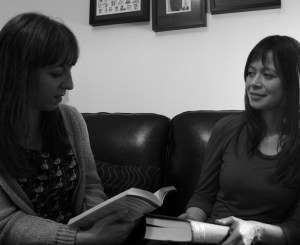
That’s Emma on the left and Emily on the right
My friend Emily and I have very different memories of our first encounters with Emma. Emily remembers reading the novel when she was in her late teens, during the Austen craze that swept the nation following the hit BBC series of Pride and Prejudice. This was a book she fondly recollects chatting about with other girls at school.
My experience, on the other hand, was far more solitary. I read it during a family holiday and recall myself at thirteen, curled up on the sofa, studiously ignoring the sounds of my friends cycling across the campsite towards our caravan. I willed the girls to ride past, hoping they’d forget to call for me. I liked them well enough but I couldn’t bear the idea of tearing myself away from my book: a £1 classic paperback version of Emma, which my parents had bought for my birthday—no doubt selected more for the coincidence of the name I share with the novel’s heroine than in expectation that it would appeal to me more than any of Austen’s other books.
When the inevitable knock sounded on the caravan door, I kept my nose deeply buried in my novel and left Mum to speak to my friends. My mother expected me to feel pleased that the girls were inviting me out to play, but I just wanted to continue reading. Although Mum acquiesced to my antisocial choice, I couldn’t help but pick up on her disappointment.
It’s taken me until now to discern the irony of my decision to eschew spending time with those girls for remaining alone with my fictional namesake—a young woman very much in need of a friend.
When Emma Woodhouse’s lifelong confidante and erstwhile governess leaves Hartfield, the estate of her employer, to set up home with a local gentleman Emma attempts to fill the gap by seeking out a replacement friend. But she makes a poor choice in Harriet—a young woman who “knows nothing herself, and looks upon Emma as knowing every thing” (Volume 1, Chapter 5). Indeed, Emma is drawn to her because she shows “so proper and becoming a deference, seeming so pleasantly grateful for being admitted to Hartfield” (Volume 1, Chapter 3). On first glance, we might worry that there’s snobbery at play here: are we being asked to criticise a friendship because it transgresses class lines?
Harriet’s lower social status is an issue, as is her lack of intellect. But these factors primarily pose problems because Emma exploits the power difference. She meddles in Harriet’s love life, for example, convincing her new friend to reject the proposal of the loving farmer Robert Martin by persuading Harriet that he is too lowly. Without a firm friend to challenge her, Emma’s worst excesses of vanity and snobbery are allowed to hold sway.
It is hardly surprising that Emma chose for herself such an unchallenging companion, since the early relationship with her doting governess offered just such a template. Emma’s formative bond with Mrs. Weston can, in part, be held to blame for the growth of her most negative character traits. The governess submitted her own will to that of her charge, and “the mildness of her temper had hardly allowed her to impose any restraint” (Volume 1, Chapter 1).
Mrs. Weston’s fault is entirely forgivable and yet nonetheless damaging: the magnitude of her love for the motherless Emma has blinded her to her charge’s flaws. And here too, class plays its part. The governess and later companion is assigned an almost impossible task. She must teach Emma to better herself and yet she lacks the equity that could help her to do so with authority and ease.
During her years as a governess, Mrs. Weston failed to convince Emma to stick with skills for long enough to hone them. When we meet the novel’s heroine as an adult she has begun many books but finished few, and her piano playing is adept but hardly accomplished. And yet Austen has dared to present us with a complex character. Emma is not simply over-indulged and self-entitled, she is also, at times, generous-spirited and selfless. She shows herself at her best when it comes to Mrs. Weston. Emma’s father continually bemoans the absence of the household’s former governess, yet Emma rises above her feelings of loss to celebrate her companion’s choice to marry and set up a life of her own. So, while Mrs. Weston’s love may have allowed Emma’s flaws to thrive, it also helped her strengths to flourish.
Emma could perhaps have exploited her strengths and minimised her flaws had she chosen Jane Fairfax to fill the space left in her life by Mrs. Weston’s marriage. Emma’s nearest and dearest consider this niece of their neighbour “so very accomplished and superior” (Volume 1, Chapter 12) that they cannot understand why Emma has not befriended her. Jane is a talented pianist and a well-educated young woman, who has learnt the joys that come from endurance; a motherless woman, who, unlike Emma, has grown up knowing that one day she must fend for herself as a governess. But Emma cannot open herself up to such a friendship, which would expose her own laziness and sense of entitlement, challenging her to better herself.
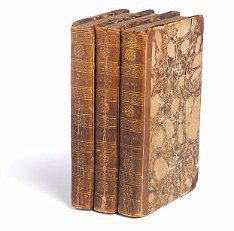
The presentation copies of Emma that Jane Austen sent to Anne Sharp
From the research my friend Emily and I have done for our website, SomethingRhymed.com, we’ve discovered that Austen herself was brave enough to make just such a choice. In her own life, Austen befriended Anne Sharp—her niece’s governess, who penned plays in between teaching lessons. The pair forged a relationship founded on intellectual parity. Even once Austen’s writing began gaining admirers as grand as the Prince Regent, Sharp never shied away from critiquing her friend’s work. Austen recorded in her notebook that Anne found Jane Fairfax insufficiently well characterised—a telling criticism from a working governess. Austen clearly valued her friend’s capacity to challenge her: she singled out the governess as her only friend to receive one of her precious presentation copies of Emma, and, just two years later, knowing that she was dying, Austen wrote one of her last letters to her “dearest Anne.”
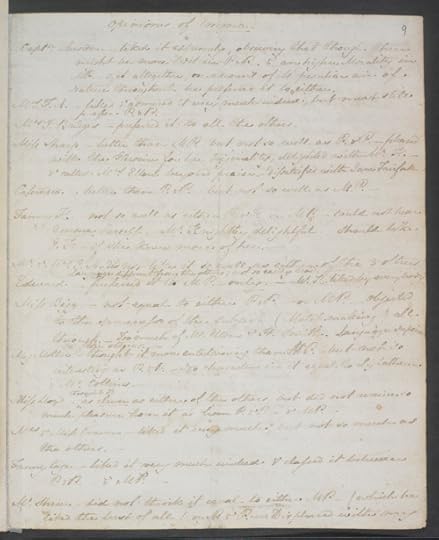
Austen’s notes on the feedback she received on Emma, including Sharp’s criticism of Jane Fairfax
When Sarah challenged me to write about female friendship in Emma as part of her online celebrations to mark the bicentenary of its publication, she didn’t just single me out. Rather, she asked me to reflect on this theme with my friend and co-writer Emily, and our post would set up in conversation with those written by lots of Jane Austen experts and fans.
And so, over twenty years since I turned away my friends in favour of befriending Emma on the page, it’s been female collaboration and camaraderie that have now drawn me back into the novel, transforming the solitary act of reading it into a communal celebration of friendship.
Quotations are from the Oxford edition of Emma, edited by R.W. Chapman (1933).
In conjunction with this guest post for my blog series, Emily interviewed Emma about romantic love and platonic friendship in Austen’s Emma, and the podcast is available beginning today at SomethingRhymed.com. Here’s the link to their conversation.
Fourth in a series of blog posts celebrating 200 years of Jane Austen’s Emma. To read more about all the posts in the series, visit Emma in the Snow. Coming soon: guest posts by Dan Macey, Catherine Morley, and Maggie Arnold.
Subscribe by email or follow the blog so you don’t miss these fabulous contributions to the celebrations! And/or follow along by connecting with me on Facebook , Pinterest , or Twitter ( @Sarah_Emsley ).

A foggy New Year’s Eve in Nova Scotia


December 30, 2015
The Long and the Short of It
 Deborah Knuth Klenck teaches classes on Shakespeare, Milton, Austen, and other writers at Colgate University, where she is Professor of English, and she has spoken at several JASNA AGMs and regional meetings. Members of our JASNA Nova Scotia Region were delighted to hear her talk last May on “Learning to Read with Emma,” and I was especially pleased to host the event at my house.
Deborah Knuth Klenck teaches classes on Shakespeare, Milton, Austen, and other writers at Colgate University, where she is Professor of English, and she has spoken at several JASNA AGMs and regional meetings. Members of our JASNA Nova Scotia Region were delighted to hear her talk last May on “Learning to Read with Emma,” and I was especially pleased to host the event at my house.
A couple of weeks before the talk, she wrote a guest post for my blog on reading and rereading Emma with Sherlock Holmes and Dr. Watson. Today I’m happy to share with you her guest post for Emma in the Snow, on long and short speeches in the novel and what they tell us about Austen’s characters.

Nova Scotia in the snow (and fog). After mild weather last week, we now have cold temperatures and quite a bit of snow in Halifax. This is what the waterfront looked like yesterday afternoon. “The Wave” sculpture next to the Visitor Information Centre at Sackville Landing is by Donna Hiebert.
I’ve been studying (in all her novels) how Jane Austen’s characters’ verbal style identifies who is right-thinking and who is wrong-headed—and sometimes even simply who is morally good or bad. In Emma, the most egregious examples of bad speech—diction, tone, and the like—are Mrs. Elton’s, of course. (Emma herself is not immune to errors of diction, like her pompous categorization of Robert Martin as one of “the yeomanry.” And, while she pounces upon Mrs. Elton for patronizing Jane Fairfax by using her Christian name, she never seems to consider how she herself addresses Harriet.)
But Sarah’s title for this blog series sent me straight to the snow, for a different aspect of bad taste in language: I’ll save diction (and the gender confusion of “cara sposo”) for another time.
The snowy episode of the Westons’ Christmas Eve party offers in a miniature dialogue a perfect example of how verbal style reveals character.
“Your father will not be easy; why do you not go?”
“I am ready if the others are.”
“Shall I ring the bell?”
“Yes, do.” (Volume 1, Chapter 15)
This terse exchange between Mr. Knightley and Emma shows their down-to-earth, no-nonsense relationship. They use no superfluous syllables. In fact, the perfect mutual understanding in these short speeches virtually announces that these characters are destined to marry. (The inaugural guest post in this series, by Nora Bartlett, draws the same conclusion from this “frank, intelligent, mutually confiding, mutually reliant exchange: no ‘he said,’ ‘she said,’ on the author’s part, no demurring and no hesitation on the characters’—here, these two are calmly decisive amidst all the confusion; they are co-operating, they are equal.”)
It so happens that Emma’s next conversation takes place in the John Knightleys’ carriage—with Mr. Elton, who is, of course
availing himself of the precious opportunity, declaring sentiments which must be already known, hoping—fearing—adoring—ready to die if she refused him; but flattering himself that his ardent attachment and unequalled love and unexampled passion could not fail of having some effect, and in short, very much resolved on being seriously accepted as soon as possible.
Emma “tried to stop him; but vainly; he would go on and say it all.” As soon as she can get a word in edgeways, she tries again to stem the tide of eloquence: “Command yourself to say no more, and I will endeavor to forget it.”
But he won’t.
In Austen’s free-indirect rendering of his speech, Mr. Elton has used almost every extant cliché in the stock vocabulary of marriage proposals—he has carefully prepared (“exactly so!”) this banal speech and is determined to get to the end.
Compare Mr. Knightley:
“I cannot make speeches, Emma:”—he soon resumed; and in a tone of such sincere, decided, intelligible tenderness as was tolerably convincing.—“If I loved you less, I might be able to talk about it more. But you know what I am.—You hear nothing but the truth from me.—” (Volume 3, Chapter 13)
If Mrs. Elton were here and could assess the difference between these two proposals the way I do, she might offer one of her habitual hackneyed expressions, a saying first used by the writer Mrs. Elton would certainly call “The Bard”: “Brevity is the soul of wit” (Hamlet 2.3.90).
(Alas, though: this is one cliché Mrs. Elton fails to live by.)
Brevity in speech or writing is one of the most reliable distinguishing characteristics of Jane Austen’s unequivocally good characters. Here’s another example: when Harriet hands Emma Mr. Martin’s letter proposing marriage,
She read, and was surprised. The style of the letter was much above her expectation. There were not merely no grammatical errors, but as a composition it would not have disgraced a gentleman; the language, though plain, was strong and unaffected, and the sentiments it conveyed very much to the credit of the writer. It was short, but expressed good sense, warm attachment, liberality, propriety, even delicacy of feeling. (Volume I, Chapter 7)
Having waited around—I imagine her hopping from one leg to the other—for Emma to finish, Harriet anxiously inquires, “Is it a good letter? Or is it too short?”
Of course, this scene is not Emma’s finest hour. She does what she can to dampen her own undeniable judgment that Robert Martin’s proposal is “a very good letter.” She needs to bolster her fiction that Mr. Martin is beneath Harriet by suggesting that, “one of his sisters must have helped him” write it. This explanation comes from another fiction, that the Martin girls have had “a superior education” to their brother’s (Volume 1, Chapter 4). But the narrative voice, with ironical litotes, has already described Mrs. Goddard’s school as a place whose alumnae emerge “without any danger of coming back prodigies” (Volume 1, Chapter 3). And Emma never contradicts Mr. Knightley’s assessment that Harriet has “been taught nothing useful” in the course of her “very indifferent education” (Volume 1, Chapter 8). Nevertheless, it suits Emma’s string of falsehoods to claim that Mr. Martin’s plain-spoken proposal has been ghost-written.
Convinced by Emma’s lies, Harriet closes out the episode with the flat observation, “it is but a short letter too.” Of course, though “Emma fe[els] the bad taste of her friend, [she] let[s] it pass with a ‘very true ’” (Volume 1, Chapter 7).
The complement to this scene is not long in coming. Harriet’s next bit of literary criticism concerns Mr. Elton’s charade. “I think it is, without exception, the best charade I ever read. . . . It is as long again as almost all we have had before.”
Oops: wrong again. Emma understates the case: “I do not consider its length as particularly in its favour. Such things in general cannot be too short.” Emma has lapsed into truth-telling for once, but “Harriet was too intent on the lines to hear.” She is busy putting together what may be the only independent thought she utters in the whole novel:
“It is one thing,” said she presently—her cheeks in a glow—“to have very good sense in common way, like every body else, and if there is any thing to say, to sit down and write a letter, and say just what you must, in a short way; and another, to write verses and charades like this” (Volume 1, Chapter 9).
Harriet has recognized an important difference between discourses, but of course her assessment is upside-down.
Volubility is not always a dangerous characteristic, though it can certainly be an annoying one. (In my opinion, Miss Bates’s good will in her gossippings exempts her from criticism: and her apparently disorganized ramblings often reveal a shrewd insight or two—as when she lets it drop that she and Mrs. Cole had guessed that Mr. Elton was courting Emma, long before Emma has come to this mortifying discovery herself.) But think of the brilliant, comical conversation between Mr. Weston and Mrs. Elton in Volume 2, Chapter 18: Mr. Weston is as determined to talk about Frank as Mrs. Elton is to talk about herself and Hymen’s saffron robe—but her fit of coughing gives him an advantage.
Perhaps it’s an inherited characteristic that Frank’s letters are as long as his father’s speeches. “What a letter the man writes!” Mr. Knightley observes of the expository epistle that makes up Volume 3, Chapters 14 and 15. And, although I had always thought that the stream-of-consciousness paragraph that punctuates the strawberry picking in Volume 3, Chapter 6 reflects a collective conversation, I’m coming around to the idea, held by the redoubtable John Mullan, that the 131 words transcribe a monologue all Mrs. Elton’s own.
Emma has certainly committed rhetorical shortcomings in the novel. Verbosity is not generally her worst offense (though holding her tongue on Box Hill would have been a good idea). Nevertheless, by the novel’s end, she has certainly learned such an elegant restraint that she barely speaks at all, despite the occasion:
—What did she say?—Just what she ought, of course. A lady always does. –She said enough to show that there need not be despair—and to invite him to say more himself. (Volume 3, Chapter 13)
All quotations are from the Cambridge Edition of Emma, edited by Richard Cronin and Dorothy McMillan (2005).
Third in a series of blog posts celebrating 200 years of Jane Austen’s Emma. To read more about all the posts in the series, visit Emma in the Snow. Coming soon: guest posts by Emily Midorikawa, Emma Claire Sweeney, Dan Macey, and Catherine Morley.
Subscribe by email or follow the blog so you don’t miss these fabulous contributions to the celebrations! And/or follow along by connecting with me on Facebook , Pinterest , or Twitter ( @Sarah_Emsley ).


December 25, 2015
Emma’s Regency Christmas
Merry Christmas! Welcome to the second guest post in my Emma in the Snow series. I’m delighted to share with you Theresa Kenney’s survey of Christmas celebrations in Jane Austen’s time and her discussion of Christmas themes in Emma.
 Theresa is a graduate of Penn State, Notre Dame, and Stanford. She’s an Associate Professor of English at the University of Dallas and former chair of the department. Her publications include Women Are Not Human: An Anonymous Treatise and Responses, The Christ Child in Medieval Culture: Alpha es et O!, “‘And I am changed also’: Mr. Knightley’s Conversion to Amiability,” and several other essays on Austen, Dickens, Bronte, John Donne, and Robert Southwell. She and her husband have two daughters, Annamaria and Stella. Theresa tells me both girls “love the Cozy Classics Emma, which has long been Stella’s favorite novel. She is two.”
Theresa is a graduate of Penn State, Notre Dame, and Stanford. She’s an Associate Professor of English at the University of Dallas and former chair of the department. Her publications include Women Are Not Human: An Anonymous Treatise and Responses, The Christ Child in Medieval Culture: Alpha es et O!, “‘And I am changed also’: Mr. Knightley’s Conversion to Amiability,” and several other essays on Austen, Dickens, Bronte, John Donne, and Robert Southwell. She and her husband have two daughters, Annamaria and Stella. Theresa tells me both girls “love the Cozy Classics Emma, which has long been Stella’s favorite novel. She is two.”
(Like Theresa’s daughters, I’m a fan of the Cozy Classics Austen adaptations. I wrote about their Emma a couple of years ago.)
Last year, Theresa wrote a guest post on “Why Tom Bertram Cannot Die” for the celebration I hosted in honour of Mansfield Park. That post also includes an account of how she discovered Austen’s novels, and how she fell in love “with Austen’s bad characters and their self-congratulatory way of speaking.”
Best wishes to all of you for a happy holiday season! Thank you for celebrating 200 years of Emma with us, and I hope you enjoy reading Theresa’s piece on “Emma’s Regency Christmas.”
England was merry England, when
Old Christmas brought his sports again.
’Twas Christmas broached his mightiest ale;
’Twas Christmas told the merriest tale.
— Sir Walter Scott, Marmion
Christmas in Austen’s Time
How did Emma celebrate Christmas? Many, thinking of Sir Walter Scott’s nostalgic regret for medieval Christmas quoted above (from Marmion, which Austen knew well), think there was not much merrymaking in early 19th century England. Poet Henry Vaughan lamented how dire the Puritan suppression of the feast was in his 1650 “Christmas: How Kind is Heaven to Man”:
Can neither Love, nor sufferings bind?
Are we all stone, and earth?
Neither His bloody passions mind,
Nor one day bless His birth?
Alas, my God! Thy birth now here
Must not be numbered in the year.
During the Interregnum, churches were even locked up on Christmas Day to prevent liturgical celebrations, and ordinary homes were policed so Cromwell’s men could confiscate meat pies, roast fowl, Yule logs, sweets, and Christmas puddings. Thomas Lewis, in his sarcastic 1720 work English Presbyterian Eloquence, states of Puritan attacks on Christmas continuing after the Restoration, “Under the censure of lewd customs they include all sorts of public sports, exercises, and recreations, how innocent soever. Nay, the poor rosemary and bays, and Christmas pie is made an abomination.”
Emma, however, probably would have eaten many of the same foods and enjoyed many of the same festive customs her forbears had known. Many time-honored Christmas customs still prevailed in English homes in the late eighteenth and early nineteenth century. The house probably would have been decorated with the traditional greenery Lewis mentions—rosemary and bay, as well as holly and ivy—although Emma would very likely not have had a Christmas tree. Because the John Knightleys are visiting with their children, however, a tree is nonetheless a remote possibility: these had already been introduced into England by Queen Charlotte, and Coleridge commented on those he saw in his European tour. Alison Barnes notes the spread of Christmas trees to many of the upper class families of England in the early 1800’s, especially those with children in the household. But Mr. Woodhouse, of course, would never have permitted a tree with candles and paper ornaments near his boisterous grandchildren!
Emma, like her author, would normally have gone to church, whether or not Christmas fell on a Sunday, which it does not in the novel’s calendar; Austen says Emma is prevented from attending by the heavy snow on Christmas Eve. Emma breathes a sigh of relief; she will not need to confront Mr. Elton or Harriet, both of whom would cause her deep embarrassment:
These were very cheering thoughts; and the sight of a great deal of snow on the ground did her further service, for any thing was welcome that might justify their all three being quite asunder at present.
The weather was most favourable for her; though Christmas-day, she could not go to church. Mr. Woodhouse would have been miserable had his daughter attempted it, and she was therefore safe from either exciting or receiving unpleasant and most unsuitable ideas. The ground covered with snow, and the atmosphere in that unsettled state between frost and thaw, which is of all others the most unfriendly for exercise, every morning beginning in rain or snow, and every evening setting in to freeze, she was for many days a most honourable prisoner. No intercourse with Harriet possible but by note; no church for her on Sunday any more than on Christmas-day; and no need to find excuses for Mr. Elton’s absenting himself. (Chapter 16)
If Emma had been able to go to the Christmas service, she would not have sung Christmas carols there. Not until 1820 was the ban on non-biblical hymn singing in church lifted. She could not have heard or sung “Silent Night” (1818, Mohr, Catholic priest), “O Little Town of Bethlehem” (1868, Brooks, Episcopalian minister), “It Came Upon a Midnight Clear” (1849, Sears, Unitarian minister), or “O Holy Night” (1843, Cappeau, anticlerical atheist). Among the few Christmas songs familiar to a modern audience that Austen might have known, from celebrations outside church, are “O Come, All Ye Faithful” (Wade 1751, Catholic layman, probably translating a text by Catholic King John Of Portugal, ca. 1640), “Whilst Shepherds Watched Their Flocks” (Tate, Puritan dramatist, 1700) and “Hark the Herald Angels Sing” (C. Wesley, Methodist minister, 1739, though the original melody was not the Mendelssohn melody used today). (See Daniel Pyle and Rebecca H. Jamison for more on carols.)
Sir Walter Scott refers to Yule logs, festive greenery, singing, and mumming as part of Christmas celebrations of old, in a passage Jane Austen would have read in Marmion (her famous comment about “dull elves” is an emended quotation from this work). Would Austen and her Emma have had Yule logs? Although they were probably brought in with less ceremony than of yore, and their lighting and extinction attended by fewer superstitious speculations about good fortune and deaths in the new year, the Yule log certainly appeared in the form of spectacular Christmas fires, a detail Austen notes especially when referring to Christmases in the novels: at the Box Hill picnic, Mrs. Elton speaks of stories being told by the fireside at Christmas; in Chapter 14 of Persuasion, Austen speaks of the “roaring Christmas fire” at the Musgroves’, where we also find the girls cutting up gold paper and silk and the boys holding “high revel” as the table “bends under the weight” of brawn and pies. Like the Musgroves, Mr. Woodhouse is a host in the old style, however much he warns his guests against eating the food he provides. His Christmas tables would have been generous affairs, and Mr. Elton’s drunkenness assures us that “Mr. Weston’s good wine” had flowed liberally at Randalls, emboldening the curate to bestow upon Emma the unfortunate Christmas gift of a Dreadful Proposal in the carriage on the way home.
Emma probably would have drunk spiced wine herself, and eaten meat and mince pies (condemned by special provision by the Puritan government but reintroduced after the Restoration). Austen’s brother Edward’s family enjoyed a Twelfth Night celebration in 1809, so it is safe to assume the feasting at Randalls and Hartfield lasted the full twelve days of Christmas, even if John and Isabella left as soon as the roads were passable.
The crèche scene so universally known nowadays had not been a normal part of English Christmas decorations even before the Reformation (in fact, the figure of Baby Jesus, if present at all, was usually molded of bread and occupied the top of the mince pie, which before Cromwell’s reign, was shaped like a manger bed. Baby Jesus never came back, even after the Restoration). Emma would not set up a stable with figures of the Holy Family and shepherds. Nor would she set candles in the windows, an Irish custom, and no doubt she would never have heard of luminarias, poinsettias, or las posadas.
The Importance of Christmas Themes in Emma: Dangerous Games
Austen sets up the calendar of Emma carefully to (among other things) bring Jane Fairfax to Highbury in November and John and Isabella Knightley to Hartfield in December for the Christmas festivities. Jo Modert and Ellen Moody have worked out the timeline of Emma and shown that it revolves around the cycle of the year, and in particular that it emphasizes certain periods of the liturgical year. Christmas is not just important as a marker of temporal flow, however: it has a persistent if subtle presence through the novel. There are six mentions of Christmas in Emma. There are actually more—seven—in Mansfield Park, most of them associated with Edmund’s taking orders then. Among these is Mary Crawford’s important question to Fanny about Edmund’s prolonged stay in Peterborough: “Is it Christmas gaieties that he is staying for?” in Chapter 29. When Mary Crawford speaks of Edmund’s staying with the Owens family for Christmas gaieties, it is because the feast lasted through the twelve days of Christmas in Austen’s day, just as it had before Cromwell. As mentioned above, we know from an 1809 letter from her niece, Fanny Knight, that Austen’s family celebrated up through Epiphany:
… after Dessert Aunt Louisa who was the only person to know the characters … took one by one out of the room and equipped them, put them into separate rooms and lastly dressed herself. We were all conducted into the library and performed our different parts. Papa and the little ones from Lizzy downwards knew nothing of it and it was so well managed that none of the characters knew one another … Aunt Louisa and L. Deeds were Dominos; F. Cage, Frederica Flirt (which she did excellently); M. Deeds, Orange Woman; Mama, Shepherdess; Self Fortune Teller; Edward, beau; G, Irish Postboy; Henry Watchman; William, Harlequin; we had such frightful masks that it was enough to kill one with laughing at putting them on and altogether it went off very well and quite answered our expectations.
This letter highlights important activities associated with Christmas: masking and game playing. Among the mentions of Christmas in Emma, the most important is probably Mrs. Elton’s dismissal of the dangerous, subversive games that Frank Churchill proposes in midsummer on Box Hill:
I had an acrostic once sent to me upon my own name, which I was not at all pleased with. I knew who it came from. An abominable puppy!—You know who I mean—(nodding to her husband). These kind of things are very well at Christmas, when one is sitting round the fire; but quite out of place, in my opinion, when one is exploring about the country in summer. Miss Woodhouse must excuse me. I am not one of those who have witty things at every body’s service. (Chapter 43)
There is clearly something unseasonable about the games Frank proposes in the height of the summer heat, and as a displaced lord of misrule he encourages the atmosphere that leads to Emma’s greatest trespass in the novel, which is a casual and cruel reinforcement of social status, the opposite of the social reversals known to accompany Christmas games under the auspices of the rulers themselves. We would not expect to look for wisdom in Mrs. Elton, but she seems to be right, that the safe and convivial fireside of Christmastime somehow would make game playing a more secure and amicable activity than it is in midsummer on Box Hill.
Austen may even be thinking of Christmas games when in the June after the first Christmas, Frank, Emma, Harriet, and Jane play the alphabet game left behind from the children’s visit. Austen records that Frank says it is “a dull looking evening, that ought to be treated rather as winter than summer” (Chapter 41).
Even Christmas activities at Christmastime seem fraught with danger in Emma, as Emma’s subjection to Mr. Elton’s drunken proposal makes clear. Does Austen’s attitude toward the feast align with Mrs. Elton’s, since the playing of games of wit, charades, and puzzles are deployed throughout Emma as deceptions and underhanded mockeries of others? There is a distrust of parties and sport and game that certainly bespeaks the opposite of the merry old England Sir Walter Scott celebrates, and that aligns Emma’s creator with the severity of a Fanny Price and an Edmund Bertram when it comes to acting and playing parts. Does Emma even care about Christmas celebrations? She does not lament being forced to stay home from church; the reader must also acknowledge that if John Knightley’s advice had been followed, they never would have gone to Randalls that night and Emma would not have been offended by Mr. Elton; if no one had played any games, Jane and Miss Bates might not have had their feelings hurt and their dignity offended. As Emma sums up in reflecting upon the past in her embarrassed first visit to the parsonage after Mrs. Elton’s arrival: “A thousand vexatious thoughts would recur. Compliments, charades, and horrible blunders” (Chapter 32).
But one thing is sure: after their October wedding and trip to the sea, the next Christmas will see Mr. and Mrs. Knightley ensconced by their first Christmas fire as a couple, at Hartfield. The very hearth from which Mr. Knightley fled the night he confronted Emma over the taunting of Jane in the letterbox game, that “fire which Mr. Woodhouse’s tender habits required almost every evening throughout the year,” will replace with its festive, familial warmth “the coolness and solitude of Donwell Abbey” (Chapter 41).
Sources
Austen, Jane. Emma. 3rd edition. Ed. R. W. Chapman. London: OUP, 1933.
—. Emma: An Annotated Edition. Ed. Bharat Tandon. Cambridge, MA: Belknap Press, 2012.
Glasse, Hannah. The Art of Cookery Made Plain and Easy. W. Strahan, 1784.
Hampson, RT. Medii Aevi Calendarium or Dates, Charters, and Customs of the Middle Ages, with Kalendars from the Tenth to the Fifteenth Century. London: H.K. Causton and Son, 1841.
Johnson, Kevin Orlin. Why Do Catholics Do That? New York: Random House, 1994.
Knight, Fanny. Letter 1809 CKS U951 C107/2. Fanny Knight’s diaries are deposited in the Centre for Kentish Studies (CKS), Maidstone, and all rights belong to the Knatchbull Family Archives.
Lewis, Thomas. English Presbyterian Eloquence. London: T. Bickerton, 1720.
Stoyle, Mark. “No Christmas Under Cromwell?”
Scott, Sir Walter. Marmion: A Tale of Flodden Field. Edinburgh: Archibald Constable and Company, 1808.
Timbs, John. Something for Everybody (And a Garland for the Year). London: Lockwood and Co., 1861.
Vaughan. Henry. Silex Scintillans: or Sacred Poems and Private Ejaculations. London: Blackie and Son, 1650.
Wakefield, Julie. “Jane Austen and Christmas: Celebrating Twelfth Night.”
Second in a series of blog posts celebrating 200 years of Jane Austen’s Emma. To read more about all the posts in the series, visit Emma in the Snow. Coming soon: guest posts by Dan Macey, Emily Midorikawa, Emma Claire Sweeney, and Deborah Knuth Klenck.
Subscribe by email or follow the blog so you don’t miss these fabulous contributions to the celebrations! And/or follow along by connecting with me on Facebook , Pinterest , or Twitter ( @Sarah_Emsley ).



